TENDA TECHNOLOGY 4G301 Wireless N300 3G/4G Router User Manual Part 1
SHENZHEN TENDA TECHNOLOGY CO., LTD. Wireless N300 3G/4G Router Part 1
Contents
- 1. User Manual Part 1
- 2. User Manual Part 2
User Manual Part 1
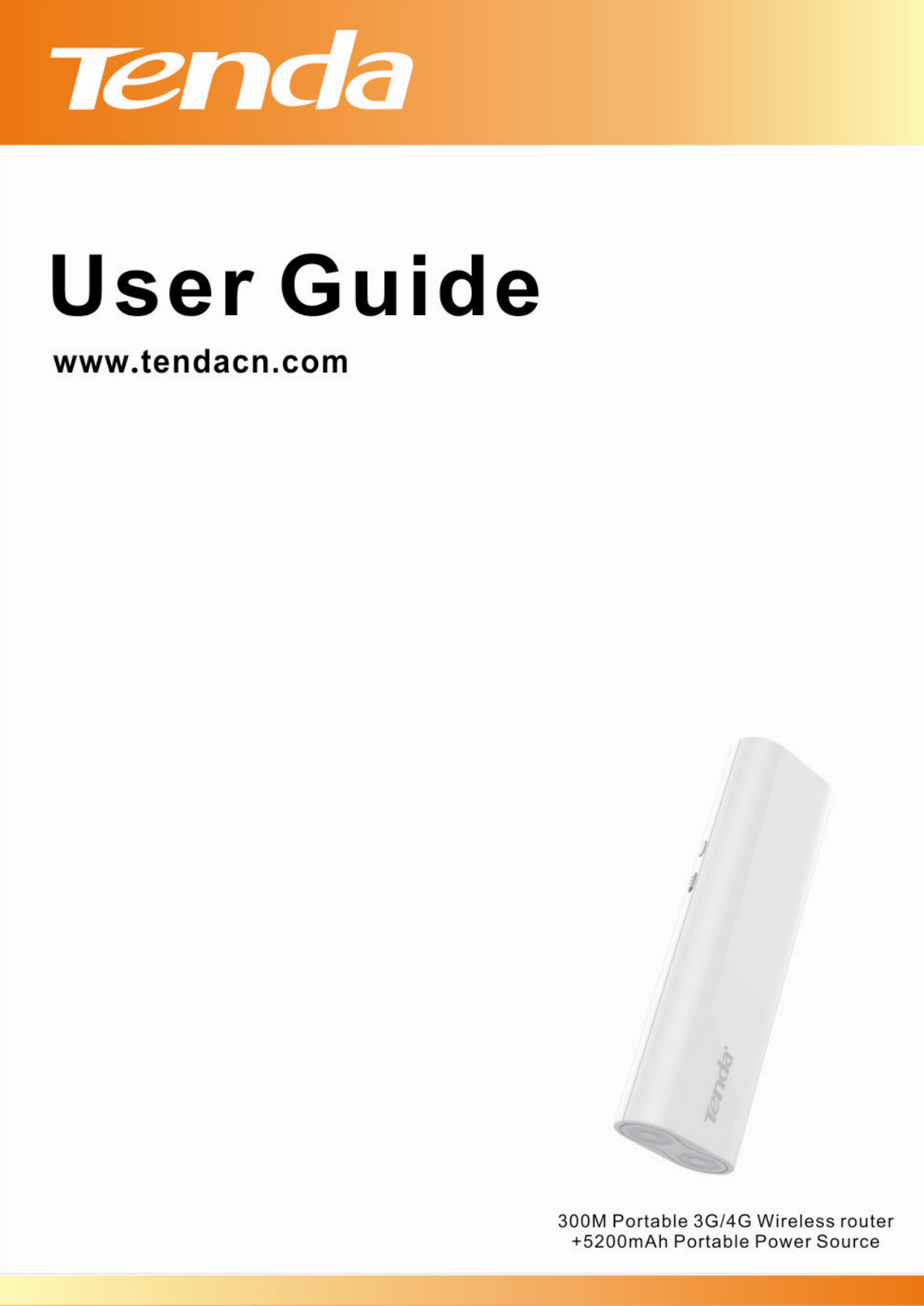
3G/4G Wireless Router User Guide
I

3G/4G Wireless Router User Guide
I
Copyright Statement
is the registered trademark of Shenzhen Tenda Technology Co., Ltd. All the
products and product names mentioned herein are the trademarks or registered trademarks of
their respective holders. Copyright of the whole product as integration, including its accessories
and software, belongs to Shenzhen Tenda Technology Co., Ltd. No part of this publication can be
reproduced, transmitted, transcribed, stored in a retrieval system, or translated into any language
in any form or by any means without the prior written permission of Shenzhen Tenda Technology
Co., Ltd. If you would like to know more about our product information, please visit our website at
http://www.tendacn.com.
Disclaimer
Pictures, images and product specifications herein are for references only. To improve internal
design, operational function, and/or reliability, Tenda reserves the right to make changes to the
products described in this document without obligation to notify any person or organization of such
revisions or changes. Tenda does not assume any liability that may occur due to the use or
application of the product or circuit layout(s) described herein. Every effort has been made in the
preparation of this document to ensure accuracy of the contents, but all statements, information
and recommendations in this document do not constitute the warranty of any kind, express or
implied.
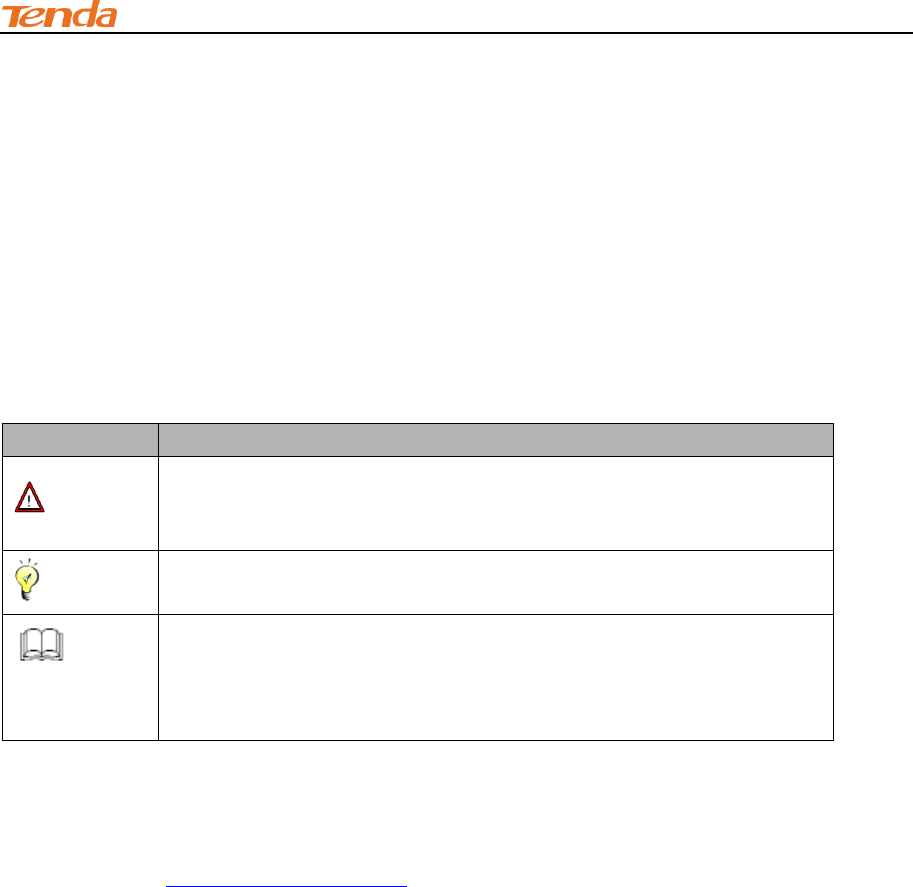
3G/4G Wireless Router User Guide
II
Preface
Thank you for choosing Tenda ! Please read this user guide before you start! This user guide
instructs you to install and configure your device. This user guide applies to 4G300, 4G301 and
4G302. The 4G301 is used as an example throughout this user guide.
This user guide uses the following formats to highlight
special messages:
Icon
Description
Note
This format is used to highlight information of importance or special
interest. Ignoring this type of note may result in ineffective
configurations, loss of data or damage to device.
Tip
This format is used to highlight a procedure that will save time or
resources.
Knowledge
Center
Description of fields on the device GUI.
Technical Support
Website: http://www.tendacn.com
Email: support02@tenda.com.cn
Skype: tendasz
YouTube: Tendasz1999
Hotline:
1-800-570-5892 (USA) (061) 1300787922 (Australia)
(044)197-780-6119 (UK) (0852)36120883 (Hong Kong)
(064) 800787922 (New Zealand)

3G/4G Wireless Router User Guide
III
Table of Contents
Copyright Statement........................................................................................................................................... I
Disclaimer ............................................................................................................................................................. I
Preface ................................................................................................................................................................. II
This user guide uses the following formats to highlight special messages: ......................................................... II
Technical Support ................................................................................................................................................ II
Table of Contents ............................................................................................................................................. III
I Product Overview ............................................................................................................................................ 1
1 Package Contents.............................................................................................................................................. 1
2 Getting to know your router ............................................................................................................................. 1
2.1 LED ............................................................................................................................................................ 1
2.2 Button & Interface ..................................................................................................................................... 3
2.3 Label .......................................................................................................................................................... 2
II Quick Internet Setup ...................................................................................................................................... 3
1 Getting Prepared ............................................................................................................................................... 3
2. Hardware Install .............................................................................................................................................. 4
2.1 Charging Router ......................................................................................................................................... 4
2.2. Hardware Install ........................................................................................................................................ 4
3 Connect to Router ............................................................................................................................................. 7
3.1 Connect to Device Wirelessly .................................................................................................................... 7
3.2 Connect to Device Using an Ethernet Cable ............................................................................................ 12
4 Smart Mode (Auto-switch between 3GRouter and Wireless Router Mode) ................................................... 12
5 Manual Internet Setup .................................................................................................................................... 13
5.1 Web Login ................................................................................................................................................ 13
5.2 Manual Internet Setup& Wireless Security Setup .................................................................................... 15
III Features & Configurations ........................................................................................................................ 25
1 Status .............................................................................................................................................................. 25
1.1 WAN Status .............................................................................................................................................. 26
1.2 LAN Status............................................................................................................................................... 27
1.3 Wireless Status ......................................................................................................................................... 27
1.4 System Status ........................................................................................................................................... 28
2 Basic Settings ................................................................................................................................................. 28
2.1 LAN Settings ........................................................................................................................................... 29
2.2 WAN Settings........................................................................................................................................... 30
2.3 WAN Speed .............................................................................................................................................. 36
2.4 DNS Settings ............................................................................................................................................ 37
2.5 MAC Clone .............................................................................................................................................. 38

3G/4G Wireless Router User Guide
IV
2.6. DHCP ...................................................................................................................................................... 39
2.7 DHCP Client List ..................................................................................................................................... 40
3 Wireless Settings ............................................................................................................................................ 42
3.1 Wireless-Basic ......................................................................................................................................... 42
3.2 Wireless Security ..................................................................................................................................... 44
3.3 Access Control ......................................................................................................................................... 45
3.4 Connection Status .................................................................................................................................... 47
4 Security ........................................................................................................................................................... 47
4.1 Client Filter .............................................................................................................................................. 48
4.2 MAC Filter ............................................................................................................................................... 51
4.3 URL Filter ................................................................................................................................................ 54
4.4 Remote Web Management ....................................................................................................................... 56
5 Advanced Applications ................................................................................................................................... 58
5.1 DDNS ...................................................................................................................................................... 58
5.2 Port Forwarding ....................................................................................................................................... 60
5.3 DMZ Host ................................................................................................................................................ 63
5.4 UPNP ....................................................................................................................................................... 64
5.5 Route Table .............................................................................................................................................. 65
6 Bandwidth Control ......................................................................................................................................... 65
7 Tools ............................................................................................................................................................... 67
7.1 Time& Date .............................................................................................................................................. 67
7.2 Firmware Upgrade ................................................................................................................................... 69
7.3 Backup & Restore .................................................................................................................................... 71
7.4 Restore to Factory Default Settings ......................................................................................................... 74
7.5 Change Password ..................................................................................................................................... 75
7.6 Logs ......................................................................................................................................................... 76
7.7 Reboot ...................................................................................................................................................... 76
IV Appendix ........................................................................................................................................................ 77
1 Configure PC TCP/IP Settings ....................................................................................................................... 77
Windows 7 ..................................................................................................................................................... 77
Windows XP .................................................................................................................................................. 83
2 FAQs ............................................................................................................................................................... 86
3 Factory Default Settings ................................................................................................................................. 87
4 Remove Wireless Network from Your PC ...................................................................................................... 88
Windows 7 ..................................................................................................................................................... 88
Windows XP .................................................................................................................................................. 90
5 Safety and Emission Statement ...................................................................................................................... 92
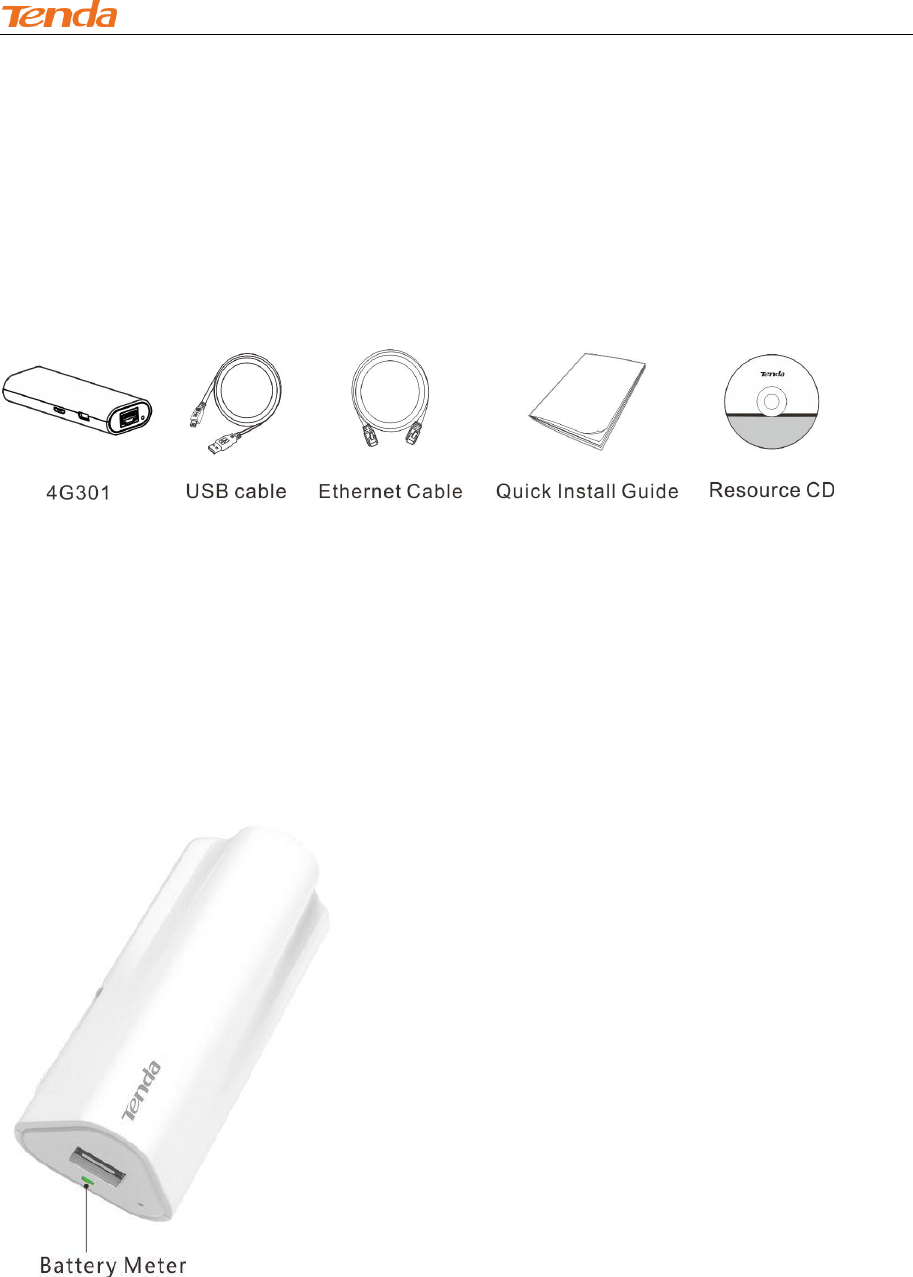
I Product Overview
1
I Product Overview
1 Package Contents
Unpack the package. Your box should contain the following items:
If any of the parts are incorrect, missing, or damaged, contact your Tenda dealer. Keep the carton,
including the original packing materials, in case you need to return the product for repair.
2 Getting to know your router
2.1 LED
4G300
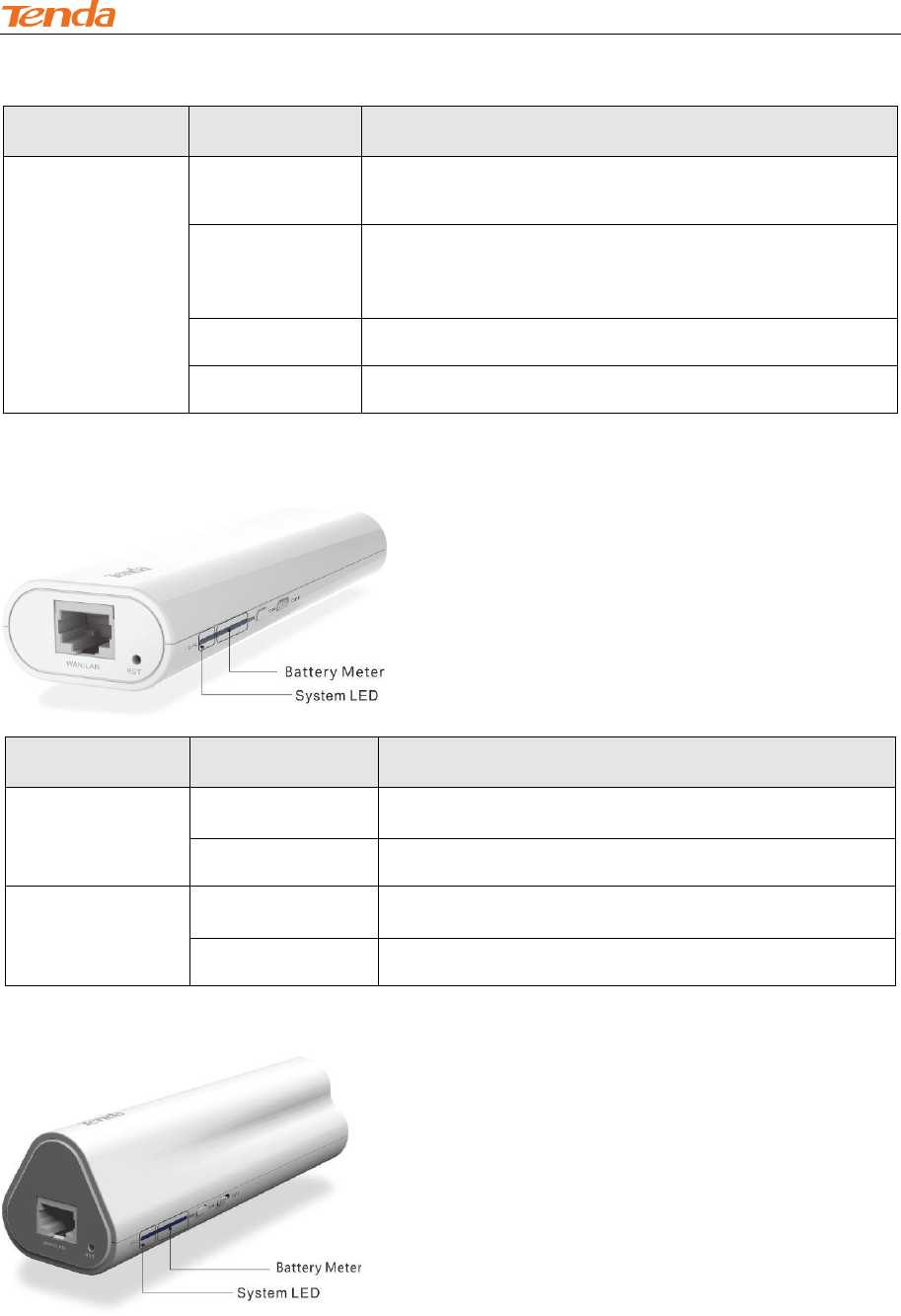
I Product Overview
2
LED
Status
Description
Battery Meter
Red
The amount of electrical energy capacity is less than
20%
Light Green
The amount of electrical energy capacity is more than
20%
Dark Green
The device is charging
Blue
The unit is fully charged up
4G301
LED
Status
Description
Battery Meter
Red
The power level is very low
Green
Display real-time level of power capacity
System LED
Blinking
The unit is starting up
Solid
The unit is functioning correctly
4G302
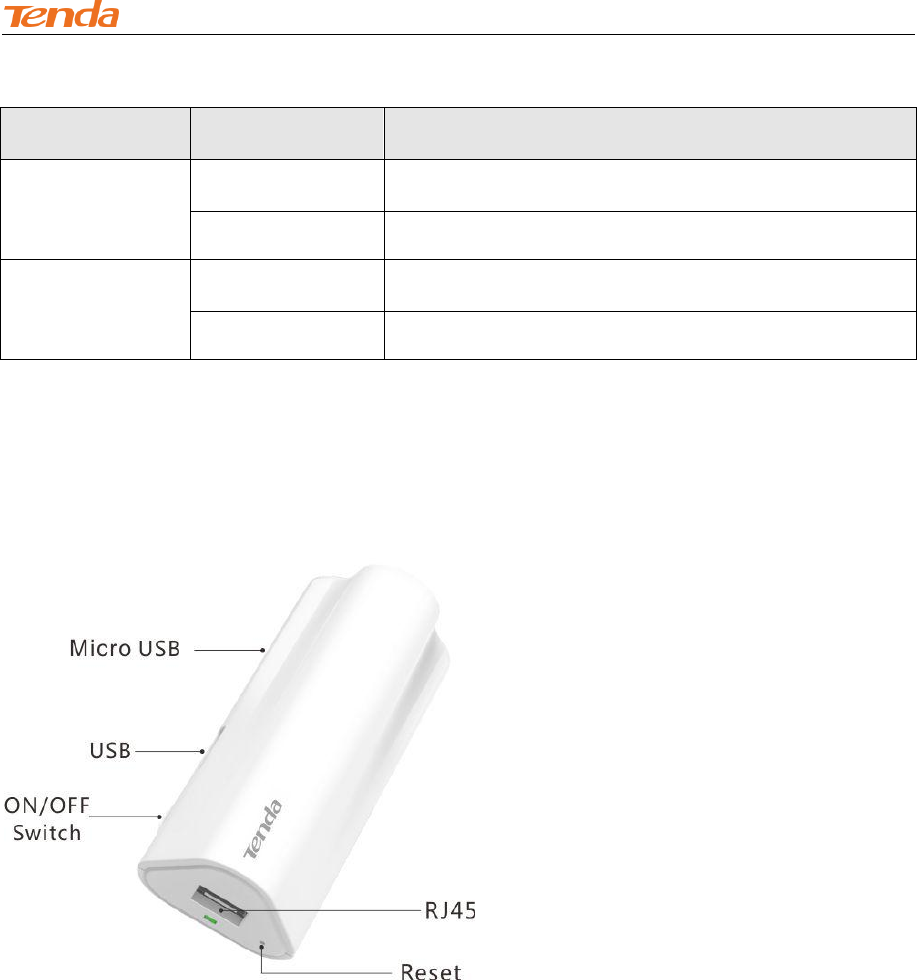
I Product Overview
3
LED
Status
Description
Battery Meter
Red
The power level is very low
Green
Display real-time level of power capacity
System LED
Blinking
The unit is starting up
Solid
The unit is functioning correctly
2.2 Button & Interface
4G300

I Product Overview
4
Button/Interface
Description
Micro USB
For charging the unit via a USB cable
USB
For connecting to a 3G/4G Modem or charging a terminal device
(such as iPad, iPhone)
ON/OFF Switch
Power button to turn the unit on or off. The unit functions as a 3G/4G
wireless router when turned on or a power bank when turned off
Reset
Pressing it with a needle for about 10 seconds resets the unit to the
factory defaults
RJ45
Functions as a LAN port for connecting to a PC or switch in 3G/4G
router mode and WISP mode. In other modes, this port functions as
a WAN port for connecting to ISP
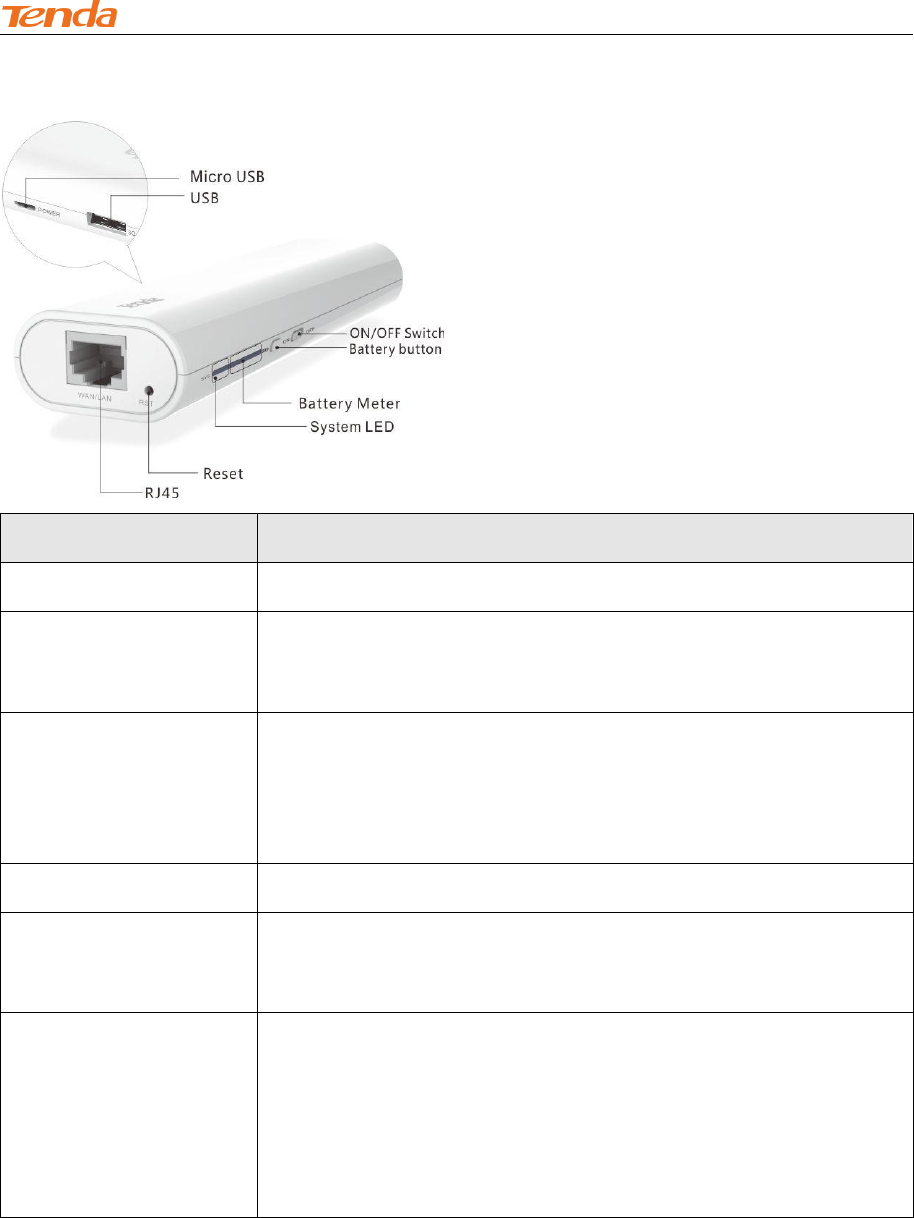
I Product Overview
1
4G301
Button/Interface
Description
Micro USB Port
For charging the unit via a USB cable
USB
For connecting to a 3G/4G Modem or charging a terminal device
(such as iPad, iPhone)
ON/OFF Switch
Power button to turn the unit on or off. The unit functions as a 3G/4G
wireless router when turned on or a power bank when turned off
Battery Meter
Press it to view power level
Reset
Pressing it with a needle for about 10 seconds resets the unit to the
factory defaults
RJ45
Functions as a LAN port for connecting to a PC or switch in 3G/4G
router mode and WISP mode. In other modes, this port functions as
a WAN port for connecting to ISP

I Product Overview
1
4G302
Button/Interface
Description
Micro USB
For charging the unit via a USB cable
USB
For connecting to a 3G/4G Modem or charging a terminal device
(such as iPad, iPhone)
ON/OFF Switch
Power button to turn the unit on or off. The unit functions as a 3G/4G
wireless router when turned on or a power bank when turned off
Battery Meter
Press it to view power level
Reset
Pressing it with a needle for about 10 seconds resets the unit to the
factory defaults
RJ45
Functions as a LAN port for connecting to a PC or switch in 3G/4G
router mode and WISP mode. In other modes, this port functions as
a WAN port for connecting to ISP
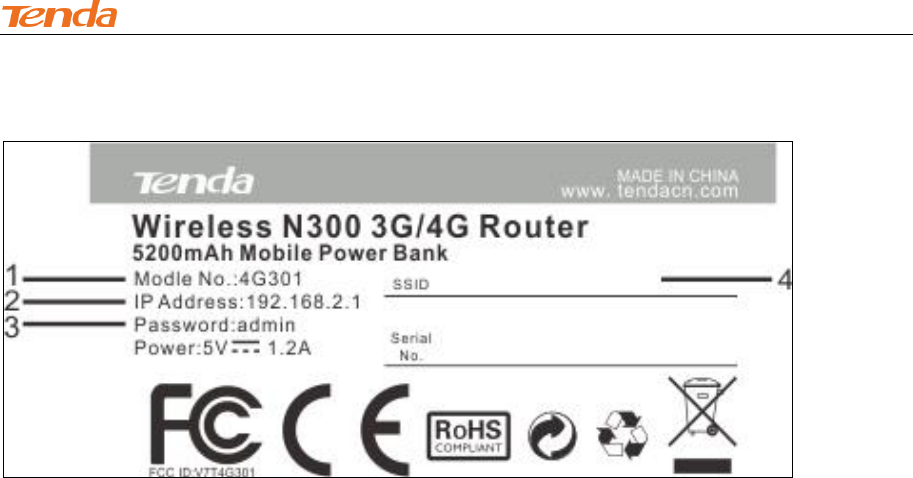
I Product Overview
2
2.3 Label
1→Product Model
2→Default Login IP address. This IP address is to be used to access the router’s settings through
a web browser. If you change it, you have to open a new connection to the new IP address and log
in again.
3→Default login password
4→Default wireless network name (SSID).
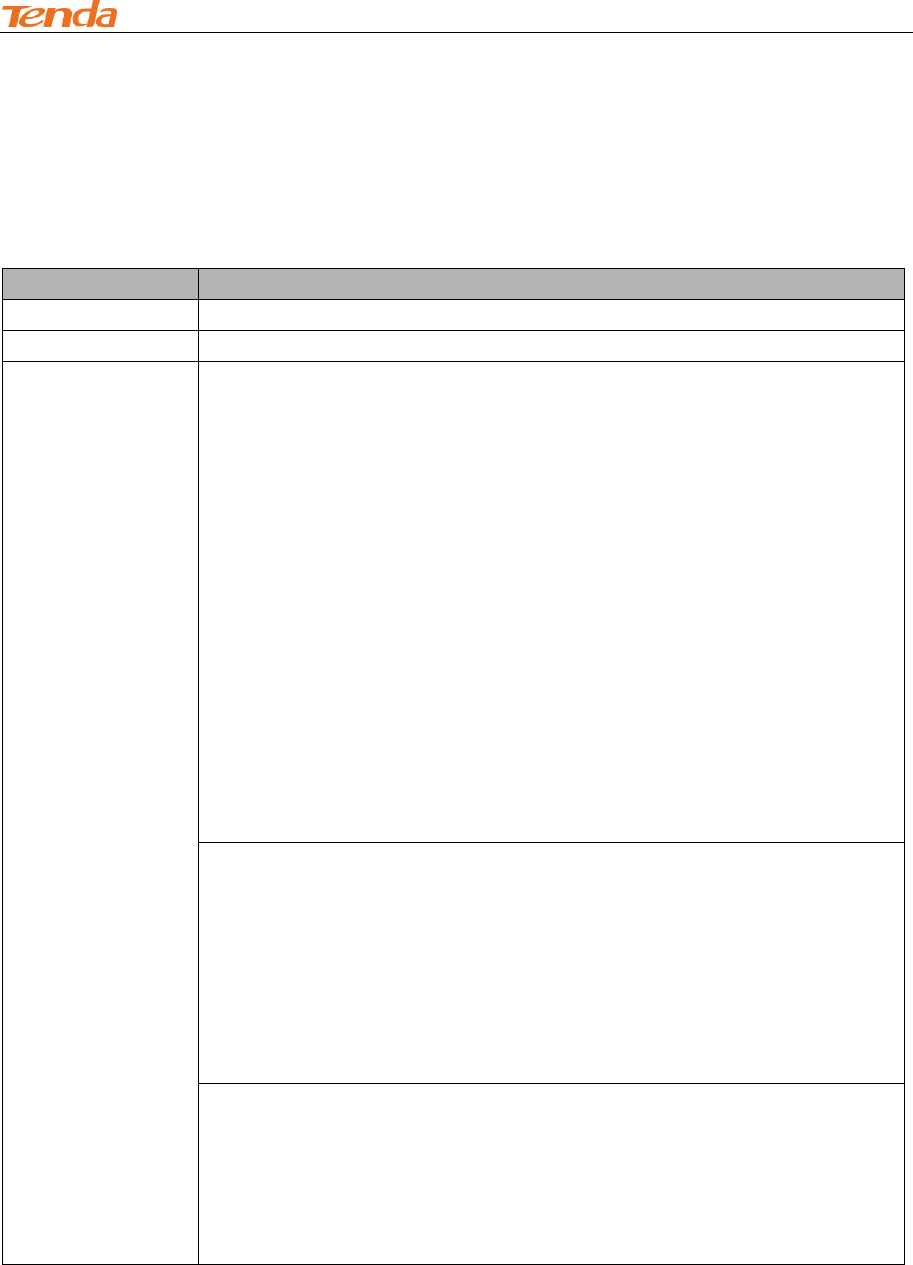
II Quick Internet Setup
3
II Quick Internet Setup
1 Getting Prepared
Before you start the installation process, you need to prepare the following:
Item
Description
Router
Find it in your package
PC
Should have a installed IE8 or higher browser
Gather ISP
Information
DHCP, PPPoE or Static IP Internet Connection Type:
1. Ethernet Cable from the incoming Internet side: This is provided by your
ISP
2. ISP Information: Your Internet service provider (ISP) should have
provided you with all of the information needed to connect to the Internet.
If you cannot locate this information, ask your ISP to provide it
If your ISP uses a PPPoE Internet connection, you will need ISP login
name and password
If you use a DHCP Internet connection, no information is needed
If your ISP gives you a fixed or static IP address for Internet
connection, you will need to gather the following information:
1) IP Address
2) Subnet Mask
3) Gateway
4) DNS Server
5) Alternate DNS Server (Optional)
3G/4G Internet Connection:
1. 3G/4G Modem: For 3G/4G Internet connection, you need to buy a
3G/4G modem
2. 3G/4G ISP Information: Your Internet service provider (ISP) should
have provided you with all of the information needed to connect to the
Internet. If you cannot locate this information, ask your ISP to provide it
3. Ethernet Cable: This can be found in the product package. You will
need it to connect your PC to this device
WISP Internet Access:
1. Remote AP's SSID, MAC address, security mode, cipher type and
security key
2. Internet connection information provided by the remote AP
3. Ethernet Cable: This can be found in the product package. You will
need it to connect your PC to this device
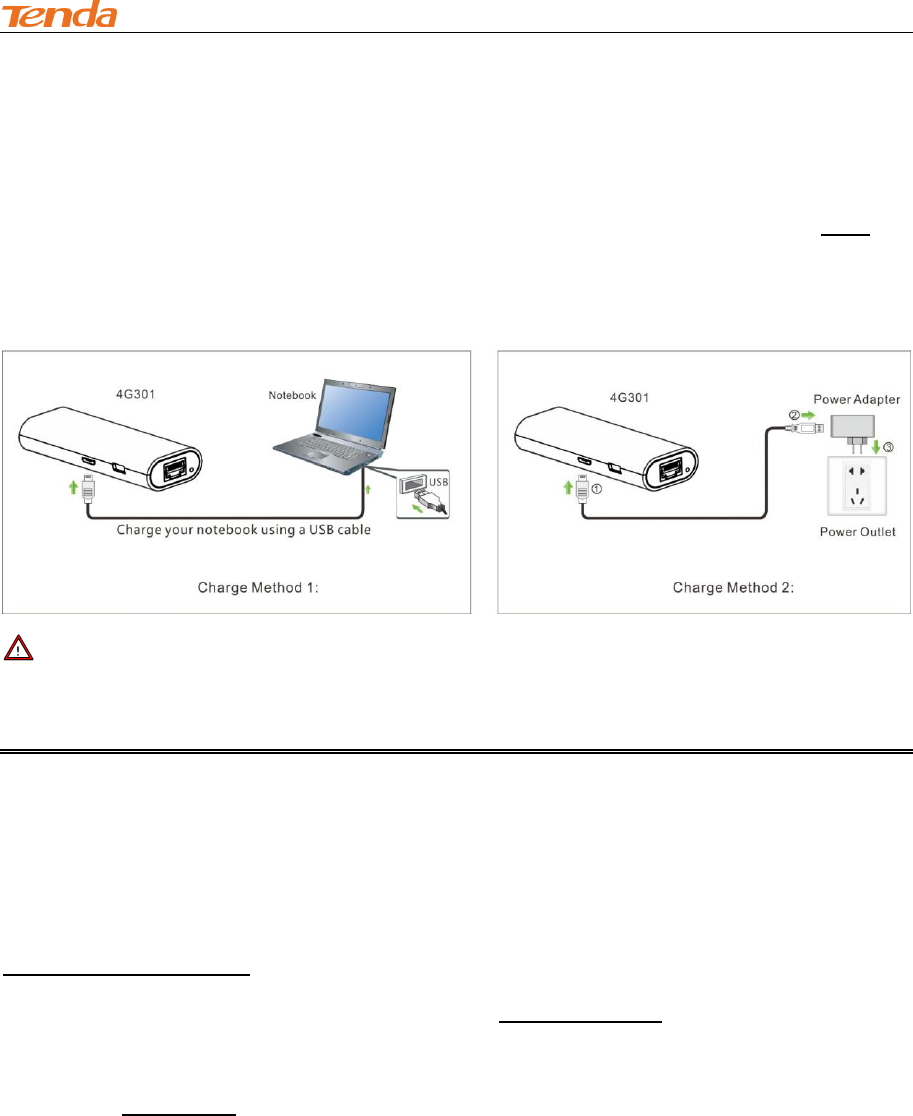
II Quick Internet Setup
4
2. Hardware Install
2.1 Charging Router
Turn on the router and check the power level indicator LED. (For LED description, see LED) It is
advisable to fully charge up the device if the amount of electrical energy capacity is less than 20%.
Charge Method:
Note----------------------------------------------------------------------------------------------------------------------
Please use the USB cable that comes in the package to charge this device. Using a different USB
cable might cause damage to this device.
2.2. Hardware Install
Select a hardware install method according to your environment.
A. If you access Internet by connecting to the Ethernet cable from the incoming Internet side, see
DHCP, PPPoE & Static IP to install hardware.
B. If you access Internet via a 3G or 4G modem, see 3G Router Mode to install hardware.
C. If you acquire Internet access from your WISP AP or a wireless Access Point on an existing
network see WISP Mode to install hardware.
DHCP, PPPoE & Static IP
In this mode, the RJ-45 port on this device functions as a WAN port. You must connect to this
device wirelessly.
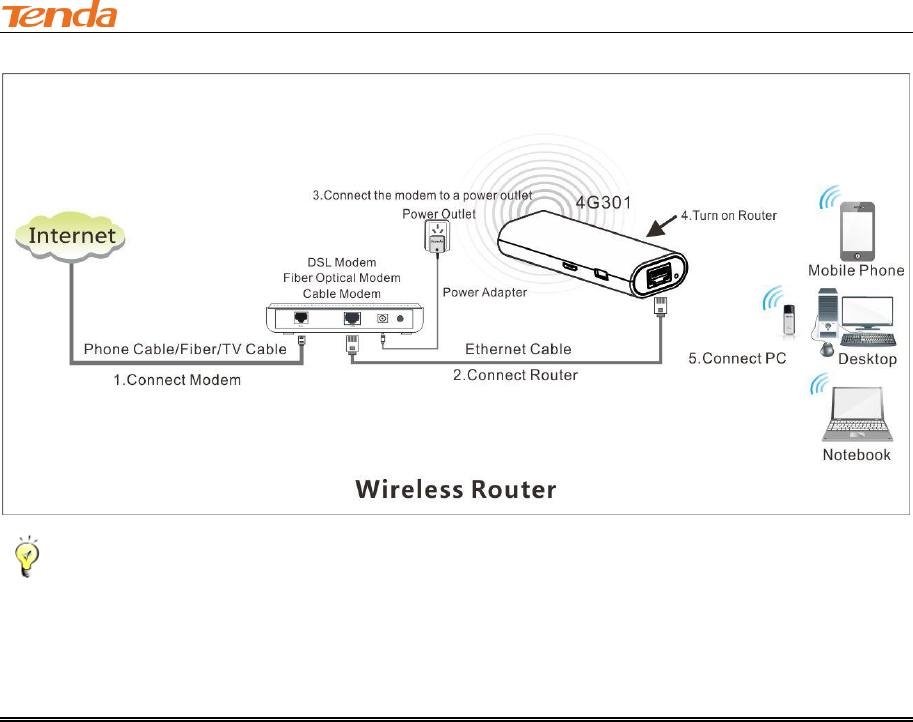
II Quick Internet Setup
5
Tip-----------------------------------------------------------------------------------------------------------------------------------------
If you want to access and configure this device via a wired connection, simply attach a 3G modem
to its USB port and system will automatically switch to the 3G Router mode. The RJ45 port will
then function as a LAN port so that you can connect to it using an Ethernet cable. Set up Internet
connection and secure your wireless network and then reconnect to this device.
3G/4G Router Mode
In this mode, the RJ-45 port on this device functions as a WAN port. You can connect to this
device using an Ethernet cable.
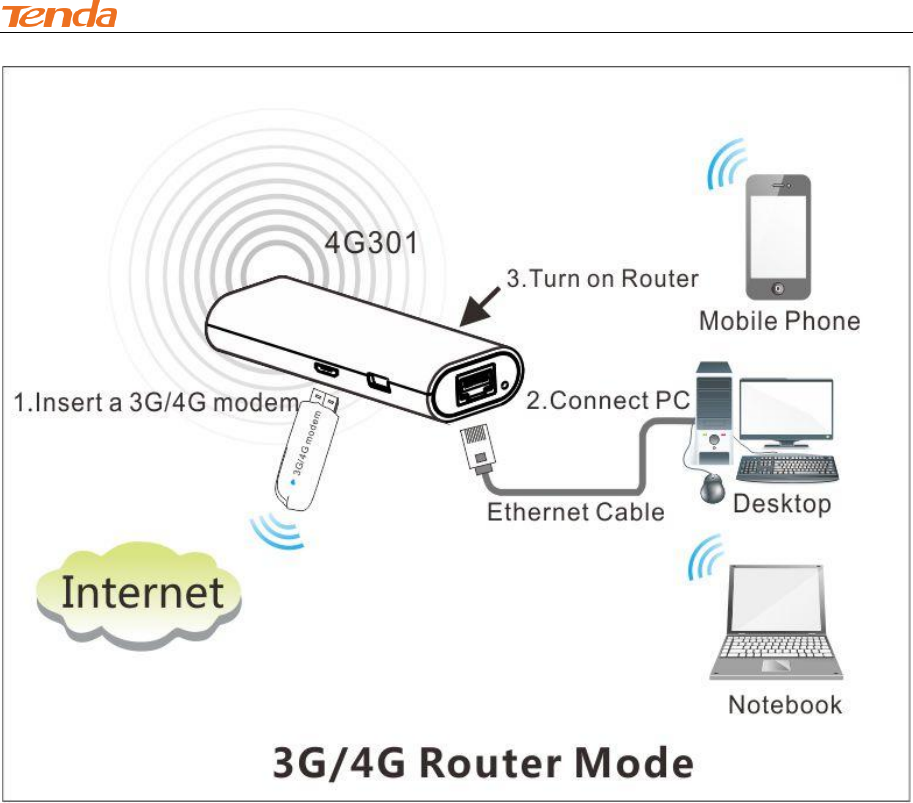
II Quick Internet Setup
6
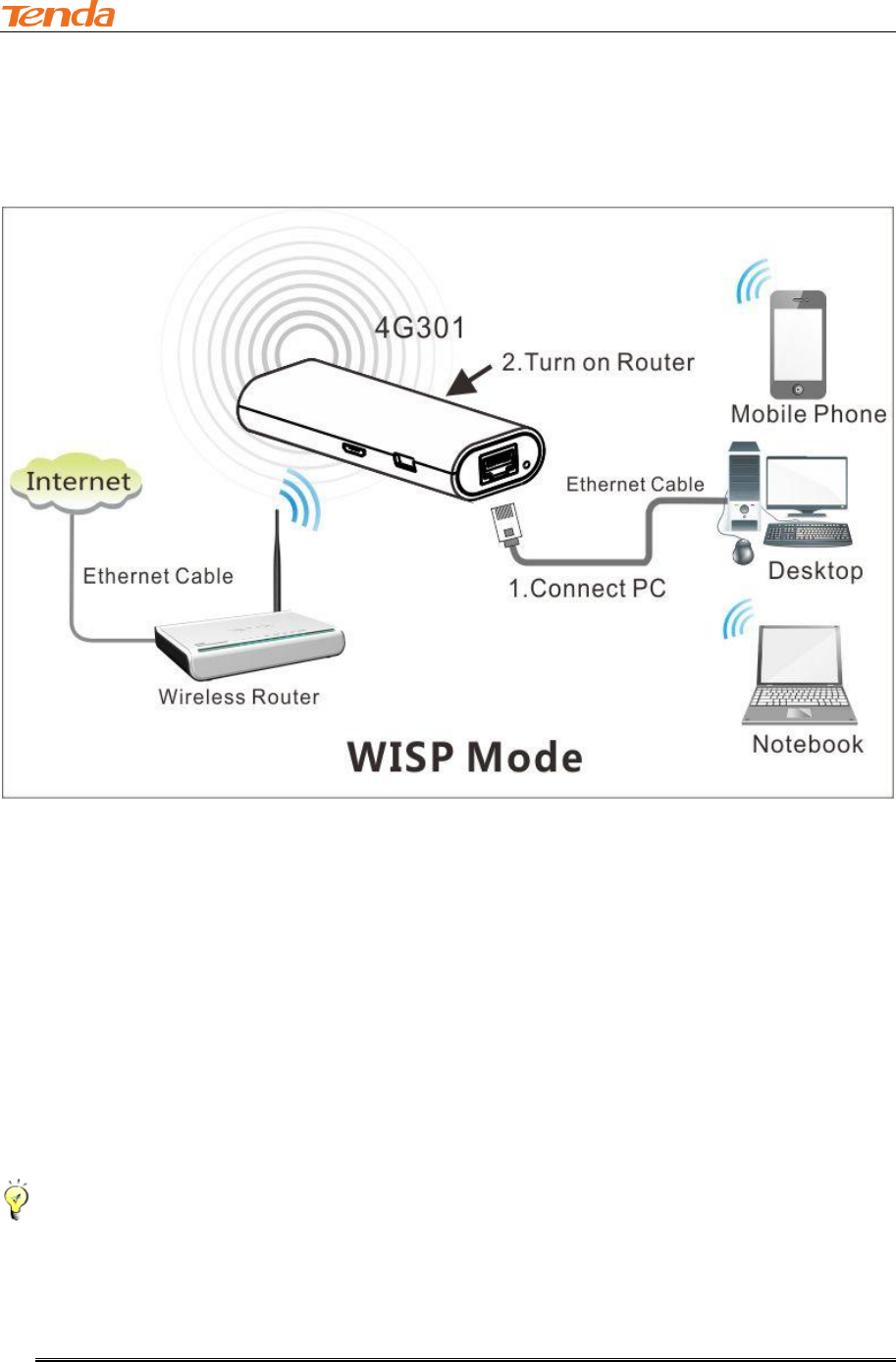
II Quick Internet Setup
7
WISP Mode
In this mode, the RJ-45 port on this device functions as a WAN port. You can connect to this
device using an Ethernet cable.
3 Connect to Router
In the Wireless Router (DHCP, PPPoE, Static IP) mode, clients (such as computers, smart phones
and tablets) can only connect to this device wirelessly for sharing Internet access. In the WISP
mode or 3G Router mode, computers, smart phones and tablets can access and connect to this
device either wirelessly or using an Ethernet cable.
3.1 Connect to Device Wirelessly
Tip------------------------------------------------------------------------------------------------------------------------
1. The device's SSID is "Tenda_xxxxxx" by default (You can find it on the attached label).
2. If you secure your wireless network, you must use the security key to join it.
3. To join your wireless network, the PC you use must have an installed wireless network
adapter. If not, install one.
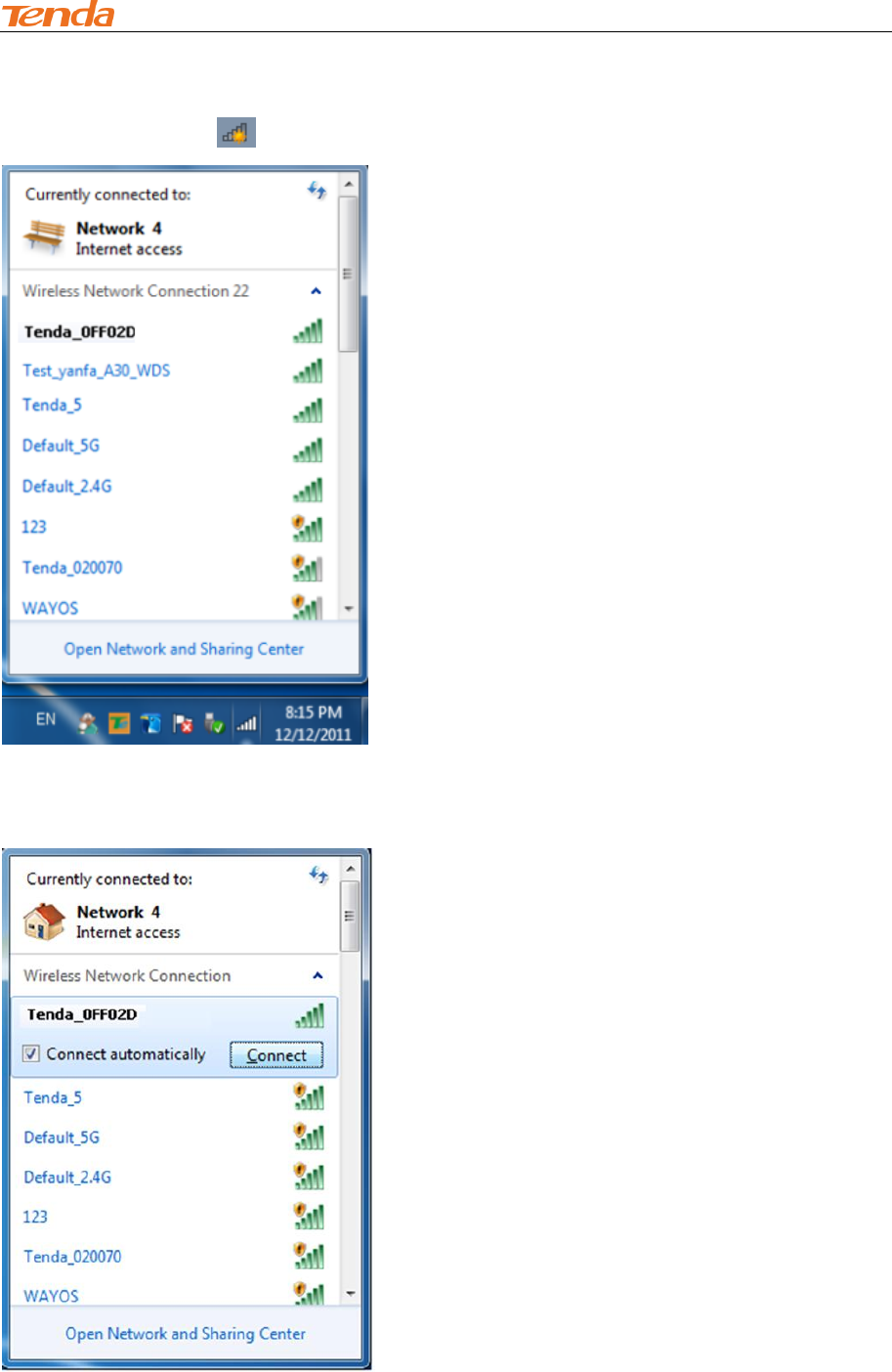
II Quick Internet Setup
8
Windows 7
① Click the icon on the notification area on the bottom right corner.
② Select the wireless network you wish to connect and click Connect.

II Quick Internet Setup
9
③ If you see the screen below, you are connecting to the wireless network.
④ Enter the security key and click OK.
When you see Connected displayed next to the wireless network you selected, you have
connected to the wireless network successfully.
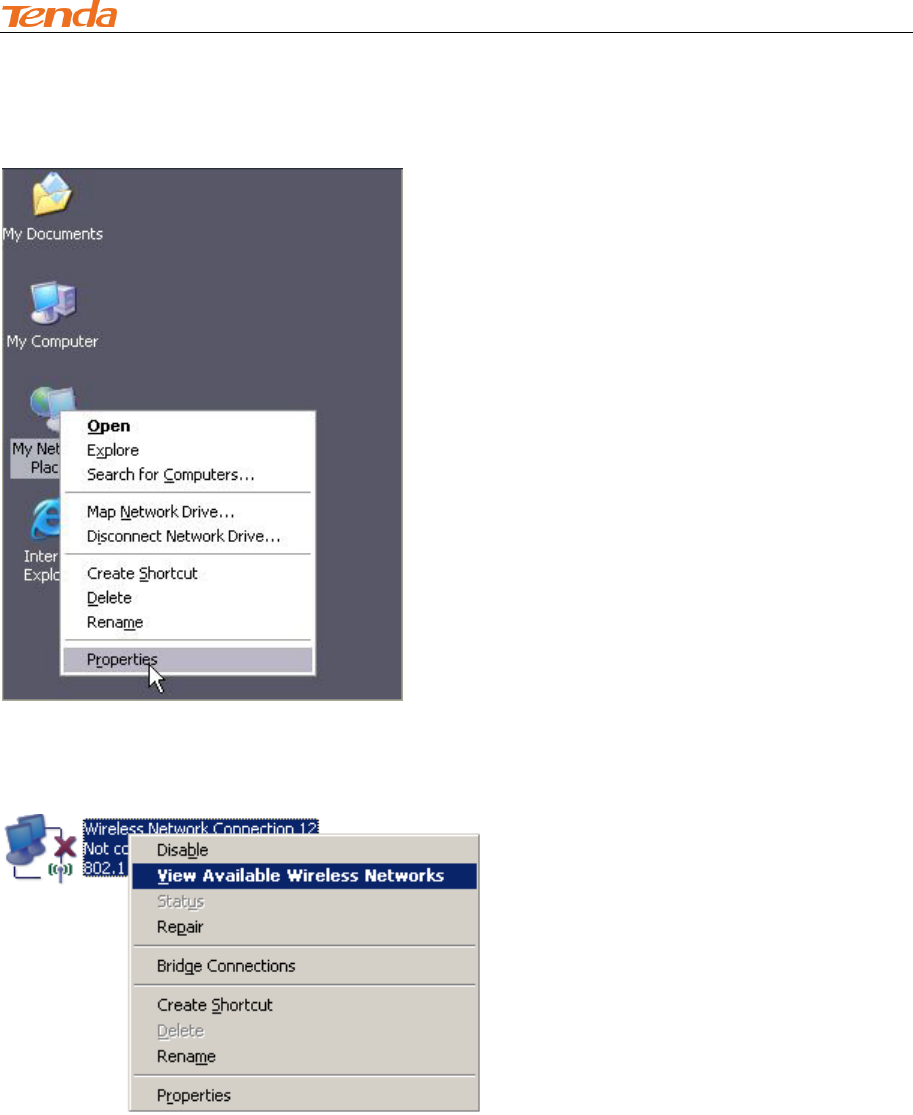
II Quick Internet Setup
10
Windows XP
① Right click My Network Places from your PC's desktop and select Properties.
② Right click Wireless Network Connection and select View Available Wireless
Networks.

II Quick Internet Setup
11
③ Double click the wireless network you wish to connect.
④ Enter the security key and click Connect.
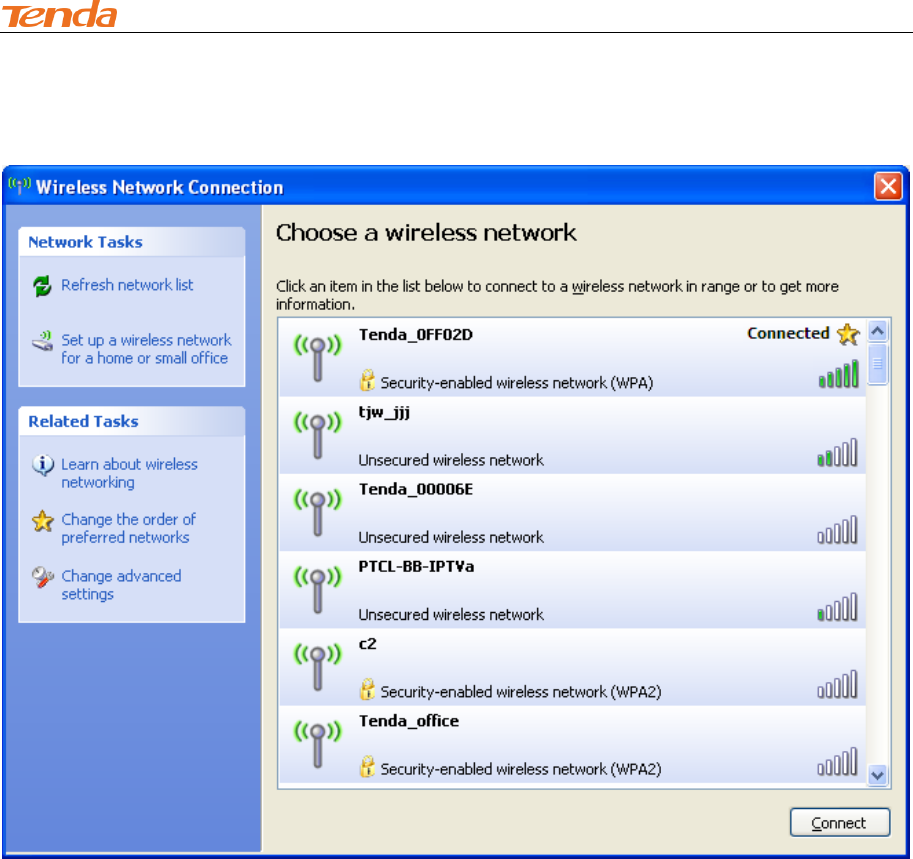
II Quick Internet Setup
12
⑤ When you see Connected displayed next to the wireless network you selected, you have
connected to the wireless network successfully.
3.2 Connect to Device Using an Ethernet Cable
If your computer is set to a static or fixed IP address (this is uncommon), change it to "Obtain an IP
address automatically" and "Obtain DNS server address automatically" from the device.
4 Smart Mode (Auto-switch between 3GRouter and Wireless
Router Mode)
The device is preset to operate in the smart mode by default.
Depending on whether there is an available 3G modem, system automatically switches to
a) 3G Router mode (in the presence of a 3G modem); clients can share Internet access either
through a wireless or wired connection to the device. There is no need for additional
configurations!
or b) Wireless Router mode (in the absence of a 3G modem): in the wireless router mode
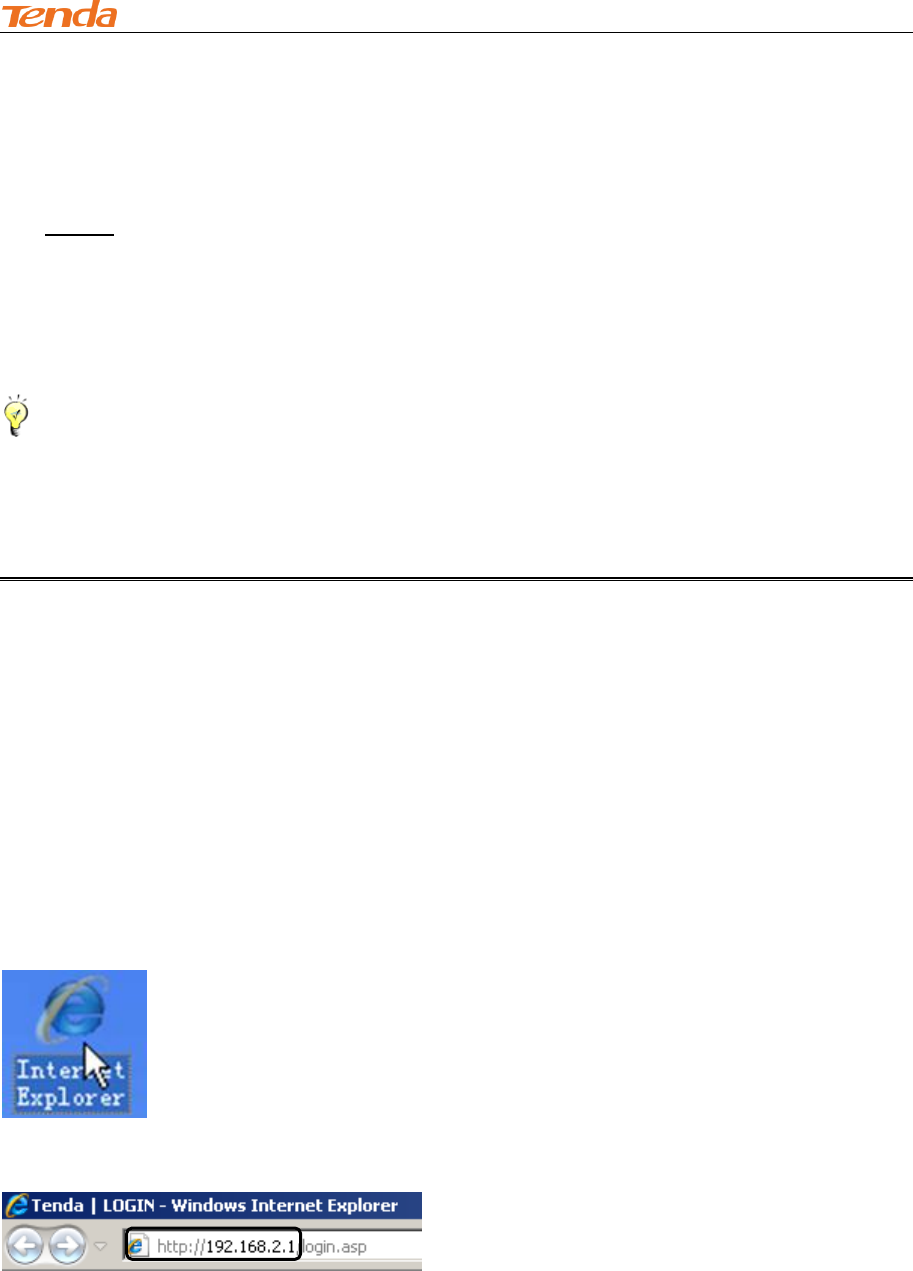
II Quick Internet Setup
13
and automatically detects and switches between PPPoE and DHCP. If you use the DHCP
(Dynamic IP) connection type, you can simply access Internet via a wireless connection to
this device, or if you use PPPoE, access this device wirelessly and then set up Internet. See
PPPoE.
When you first time open a web page after successfully connecting to Internet, you will be
prompted to customize a wireless security key to secure your wireless network. Simply follow the
onscreen instructions there.
Tip-------------------------------------------------------------------------------------------------------------------------
This device can automatically detect and switch among the DHCP, PPPoE and 3G router mode
depending on the actual environment. If the Auto-switch feature is disabled, the device will
automatically detect and switch to the right Internet connection type in case of an Internet
connection failure.
5 Manual Internet Setup
Read this section only when you fail to access Internet after you have tried the above mentioned
steps or you can access Internet and want to change the SSID (wireless network name) and
security key of this device.
5.1 Web Login
① Launch a web browser, say, IE.
② In the address bar, input 192.168.2.1, and press "Enter".
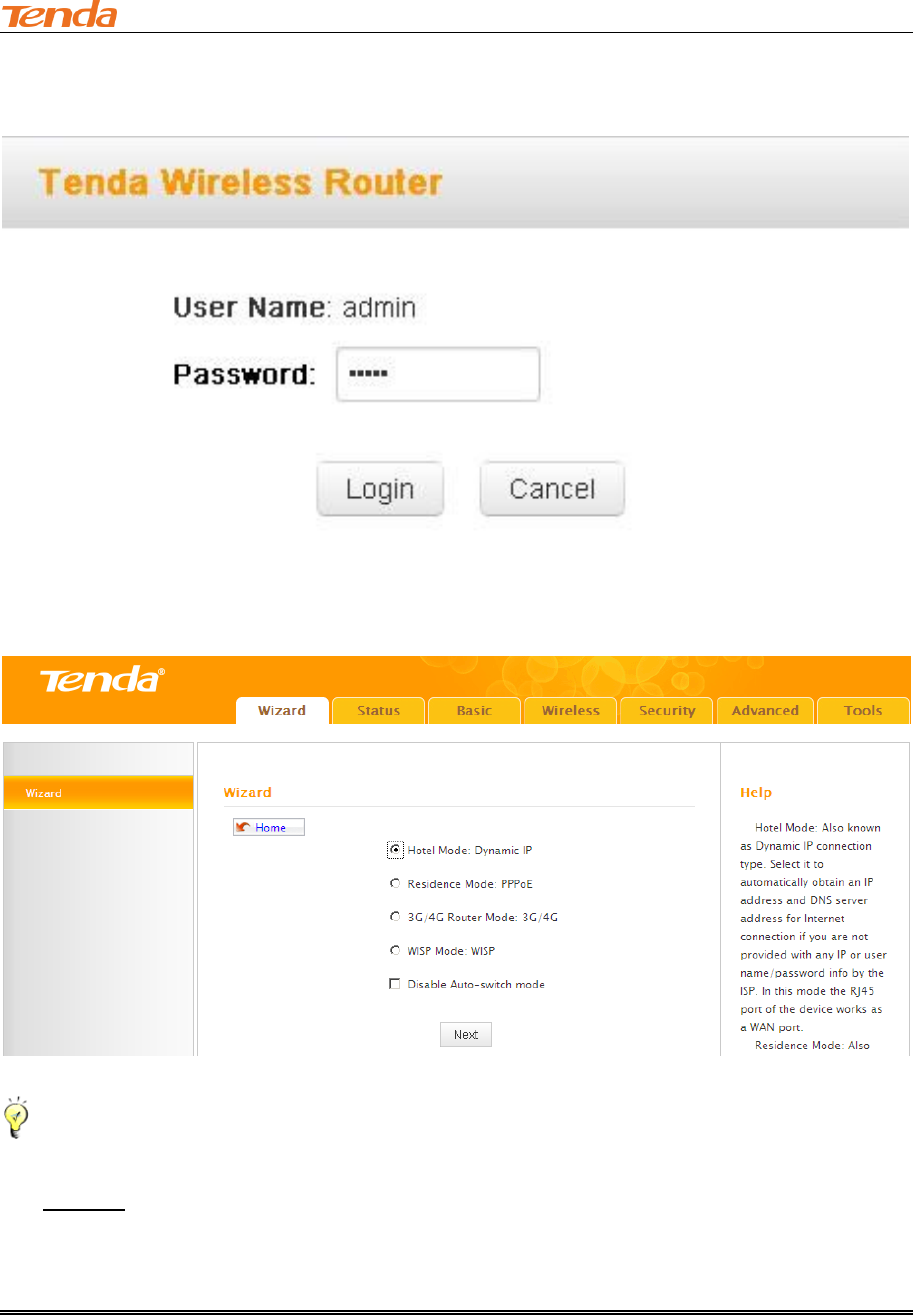
II Quick Internet Setup
14
③ Enter the login password and click Login. The default password is admin.
④ You will come to the setup wizard interface. Here you can quickly set up Internet.
Tip-------------------------------------------------------------------------------------------------------------------------------------------
1. If you access Internet by connecting to the Ethernet cable from the incoming Internet side,
see Static IP.
2. If you don't want to use the Auto-switch feature, check the Disable Auto-switch mode box.
3. You can also enable the Auto-switch mode feature after you manually set up Internet and your
wireless network so that your router can fit different environment, eliminating manual intervention.
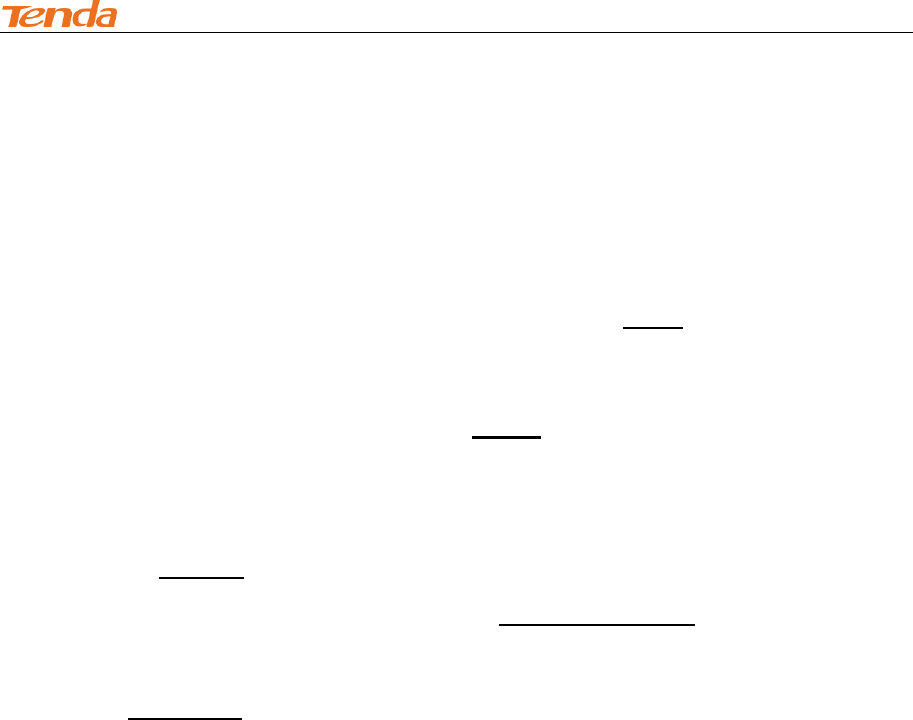
II Quick Internet Setup
15
5.2 Manual Internet Setup& Wireless Security Setup
Read the following and determine your Internet connection type. Then follow the right setup
wizard.
A. If your ISP provides you with an Ethernet cable from the incoming Internet side but no ISP login
account or IP information, your ISP uses a DHCP connection. See DHCP.
B. If your ISP provides you with an Ethernet cable from the incoming Internet side and ISP login
account, your ISP uses a PPPoE connection. See PPPoE.
C. If your ISP provides you with an Ethernet cable from the incoming Internet side IP information
(IP address, subnet mask, gateway IP address, DNS server address), your ISP uses a static IP
connection. See Static IP.
D. If you access Internet via a 3G or 4G modem, see 3G/4G Router Mode.
E. If you acquire Internet access from your WISP AP or a wireless Access Point on an existing
network, see WISP Mode.
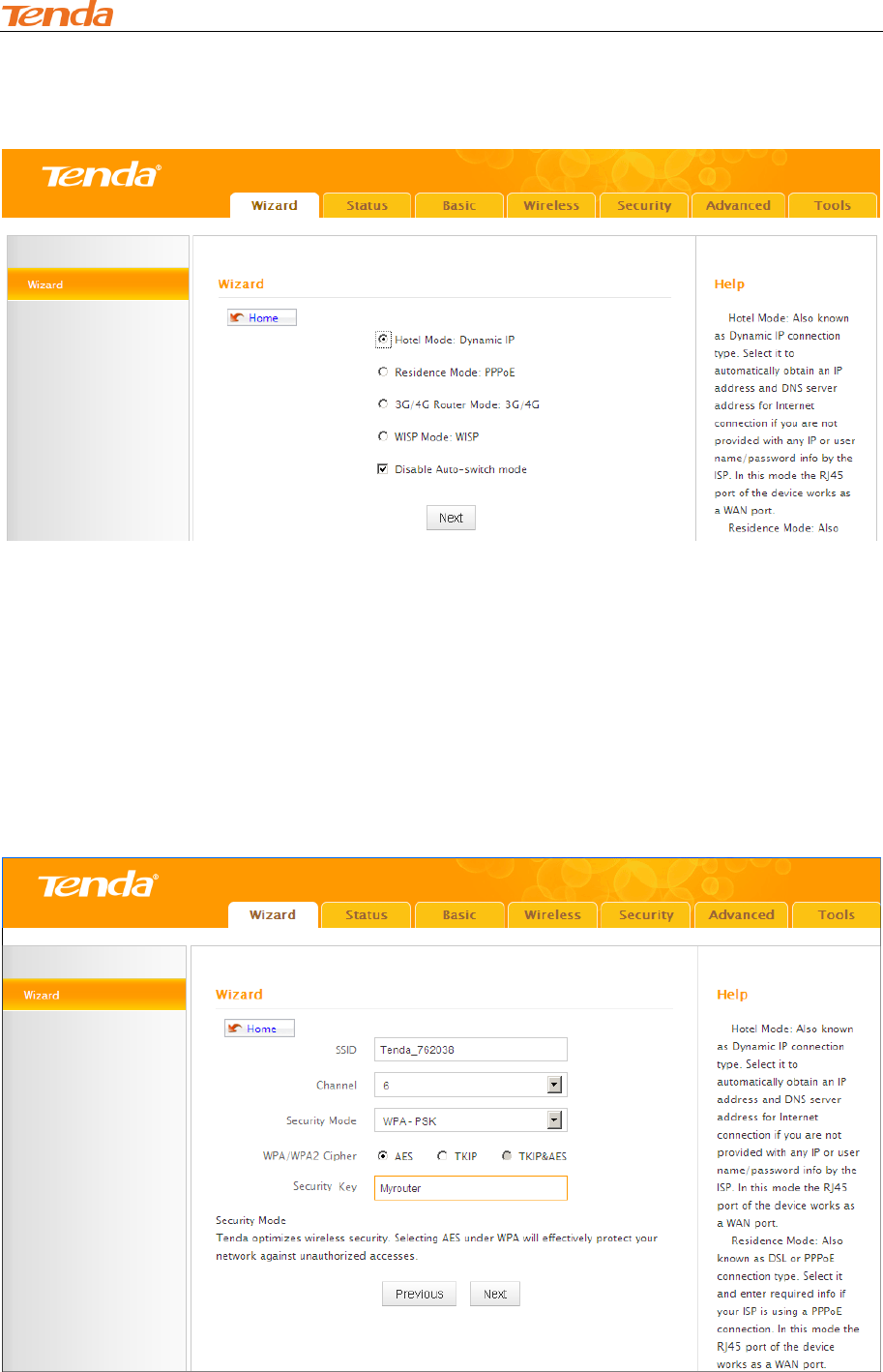
II Quick Internet Setup
16
DHCP
① Select Hotel Mode: Dynamic IP and click Next.
② Configure your wireless network: SSID, channel, security settings and then click Next.
SSID:Tenda_762038
Channel: 6
Security Mode: WPA-PSK
Cipher Type: AES
Security Key: Myrouter
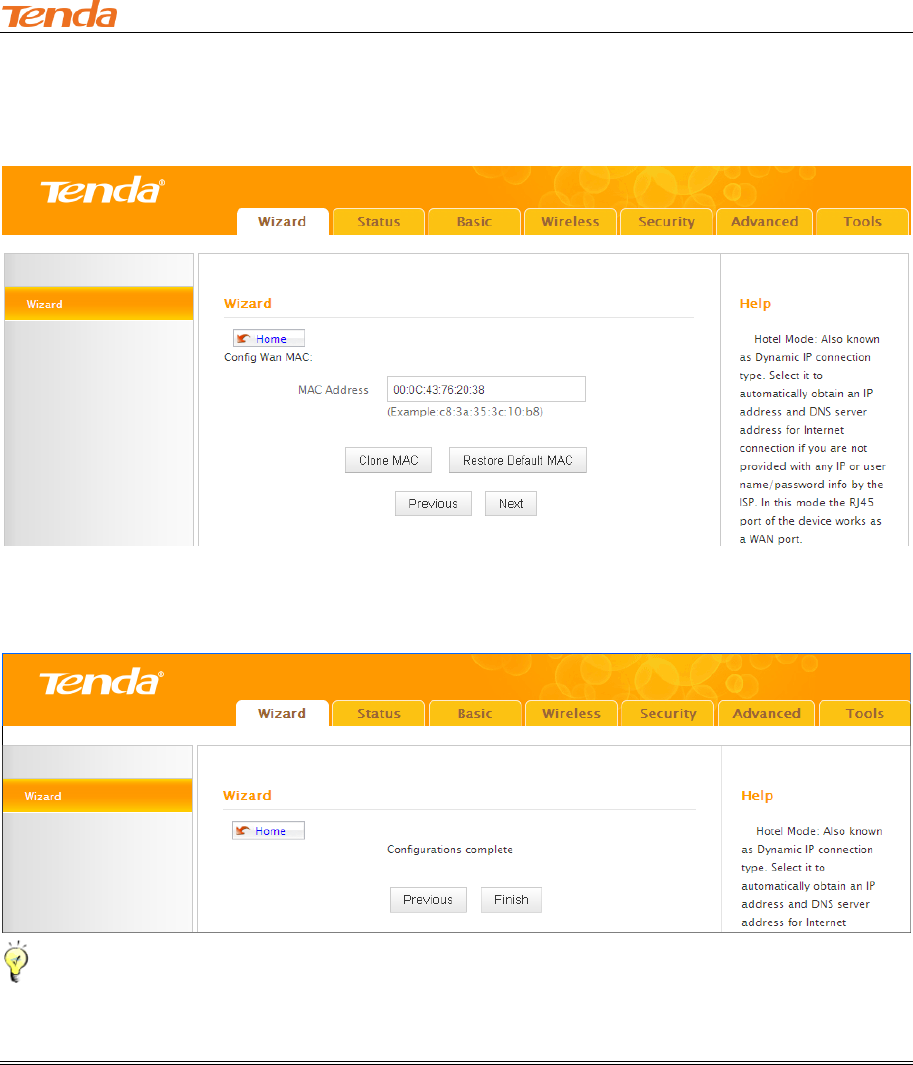
II Quick Internet Setup
17
③ MAC Clone Setup: Enter the computer or broadband modem authorized by your ISP. Then
click Next.
④ Click Finish and wait for the device to restart automatically. After reboot, reconnect to this
device wirelessly and you will be able to access Internet.
Tip-------------------------------------------------------------------------------------------------------------------------
Upon successful configuration, the RJ-45 port on the device functions as a WAN port and clients
must only access the device wirelessly.
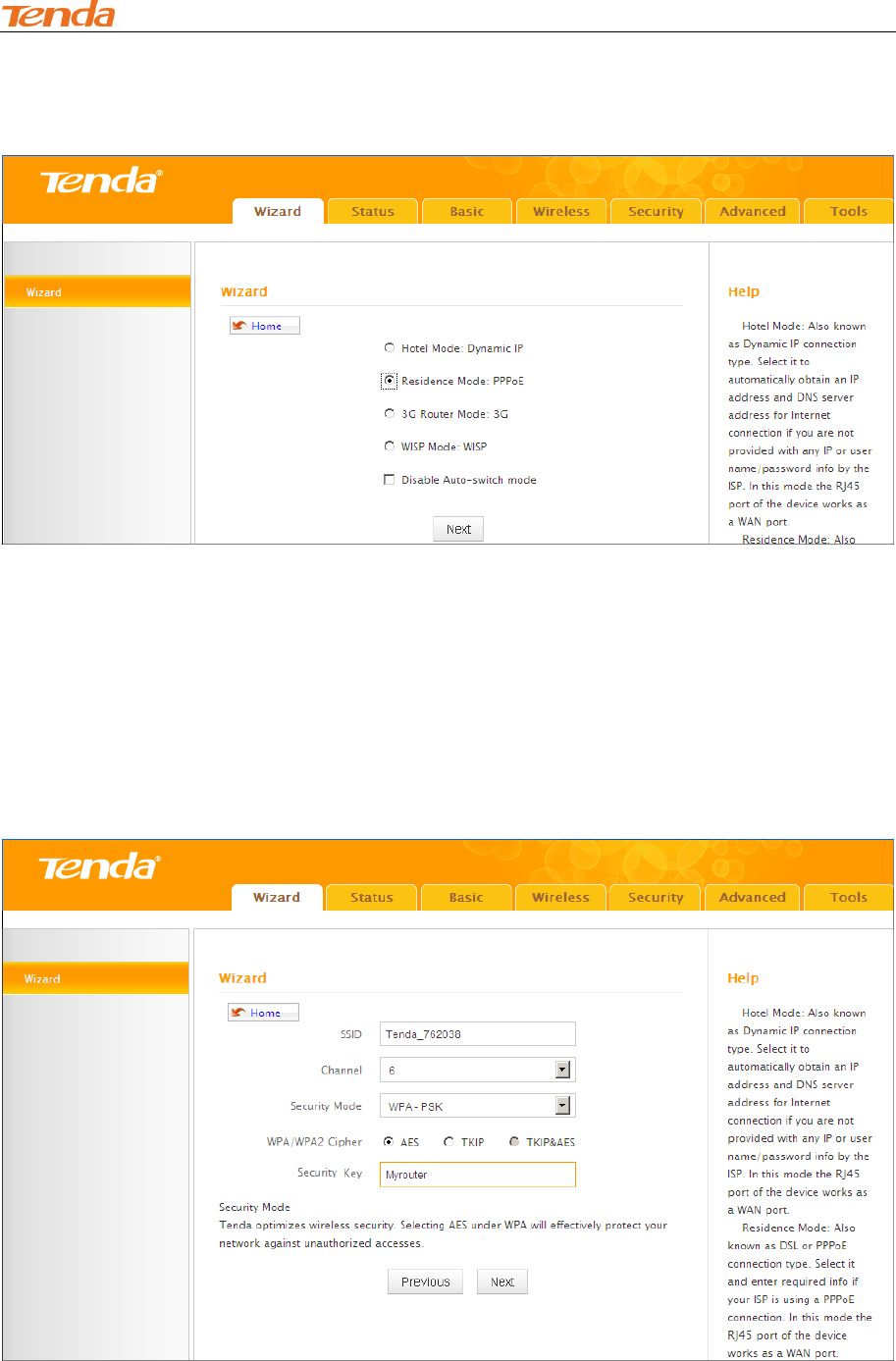
II Quick Internet Setup
18
PPPoE
① Select Residence Mode: PPPoE and click Next.
② Configure your wireless network: SSID, channel, security settings and then click Next.
SSID:Tenda_762038
Channel: 6
Security Mode: WPA-PSK
Cipher Type: AES
Security Key: Myrouter
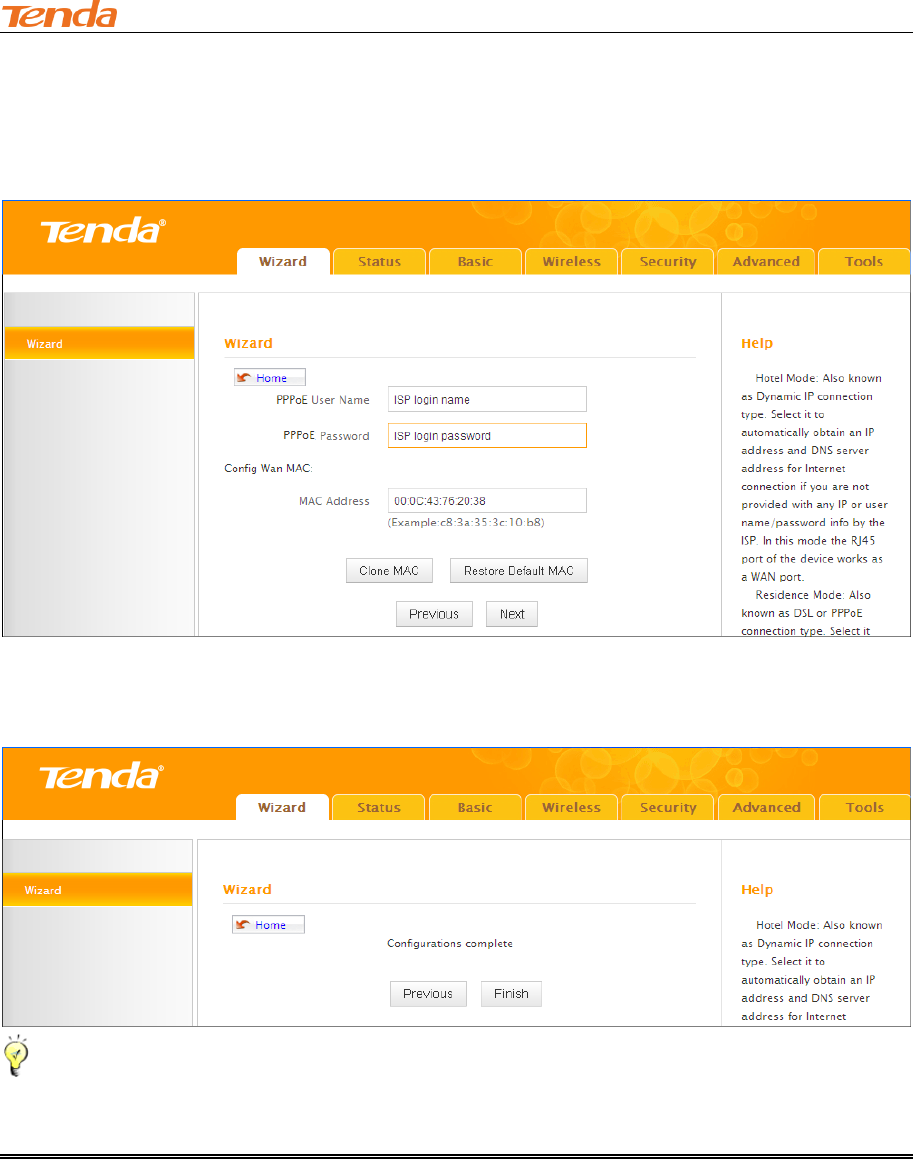
II Quick Internet Setup
19
③ Internet Setup & MAC Clone: Enter your ISP login user name and password (case sensitive)
and the MAC address of the computer or broadband modem authorized by your ISP. Then click
Next.
④ Click Finish and wait for the device to restart automatically. After reboot, reconnect to this
device wirelessly and you will be able to access Internet.
Tip-------------------------------------------------------------------------------------------------------------------------
Upon successful configuration, the RJ-45 port on the device functions as a WAN port and clients
must only access the device wirelessly.
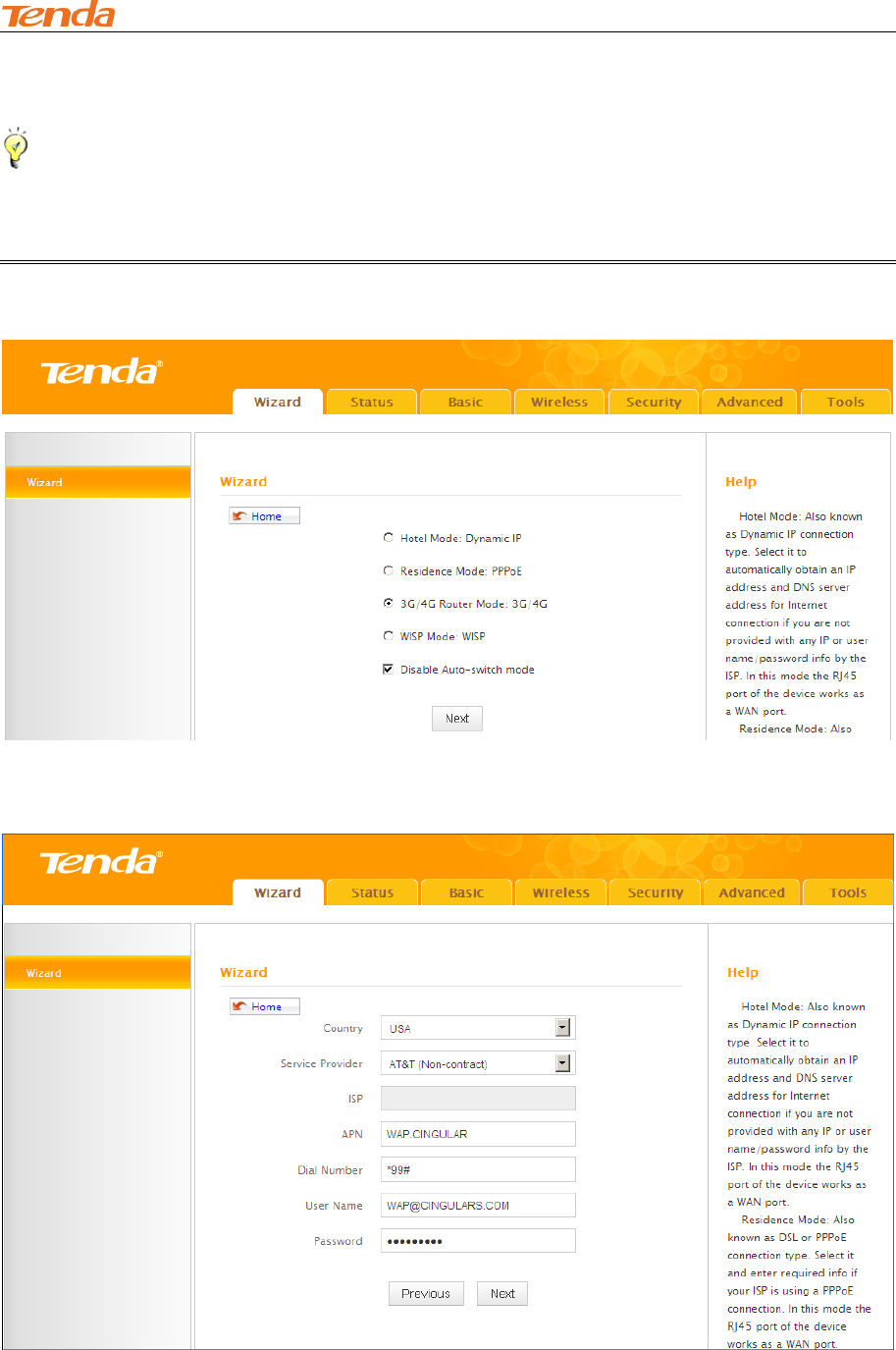
II Quick Internet Setup
20
3G/4G Router Mode
Tip-------------------------------------------------------------------------------------------------------------------------
In this mode, you only need to configure the router. No additional configurations are required on
the 3G/4G modem.
① Select 3G/4G Router Mode and click Next.
② Select your 3G ISP and click Next.
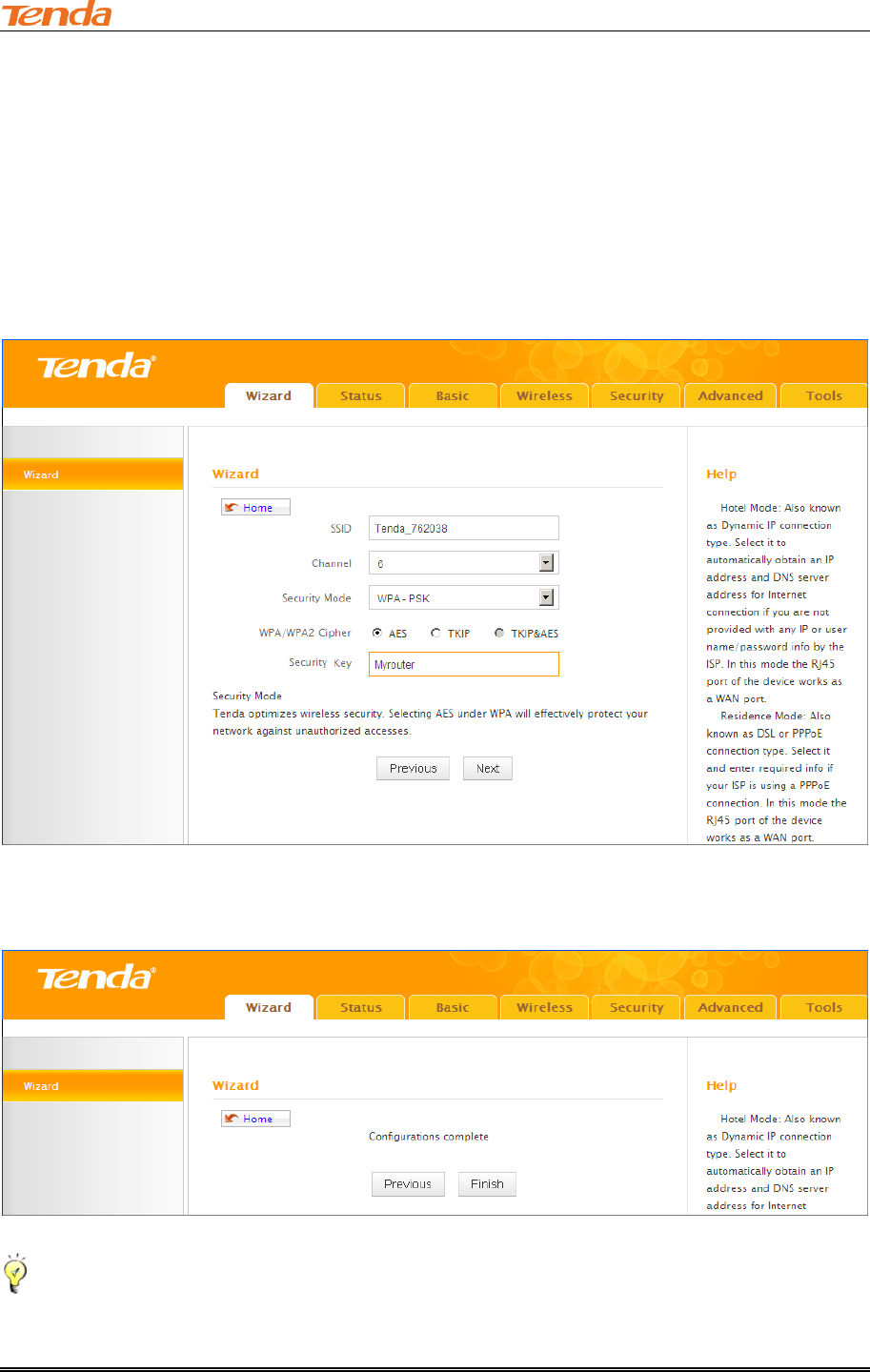
II Quick Internet Setup
21
③ Configure your wireless network: SSID, channel, security settings and then click Next.
SSID:Tenda_762038
Channel: 6
Security Mode: WPA-PSK
Cipher Type: AES
Security Key: Myrouter
④ Click Finish and wait for the device to restart automatically. After reboot, reconnect to this
device wirelessly or using an Ethernet cable and you will be able to access Internet.
Tip-------------------------------------------------------------------------------------------------------------------------
Upon successful configuration, the RJ-45 port on the device functions as a LAN port and clients
can access the device either wirelessly or via a wired connection.
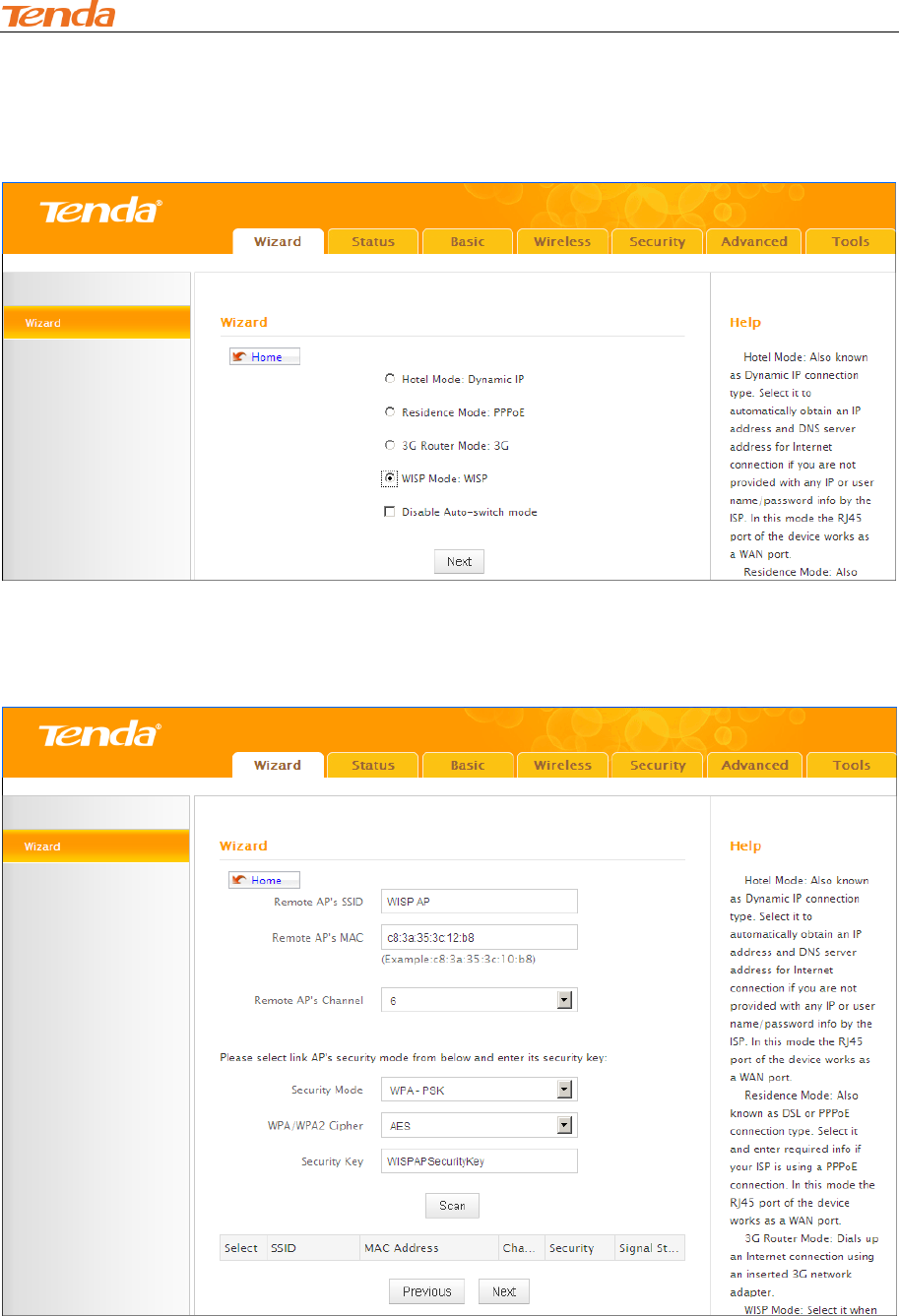
II Quick Internet Setup
22
WISP
① Select WISP Mode: WISP and click Next.
② WISP Setup: Enter or specify the SSID, MAC, channel, security settings provided by your
WISP and then click Next.
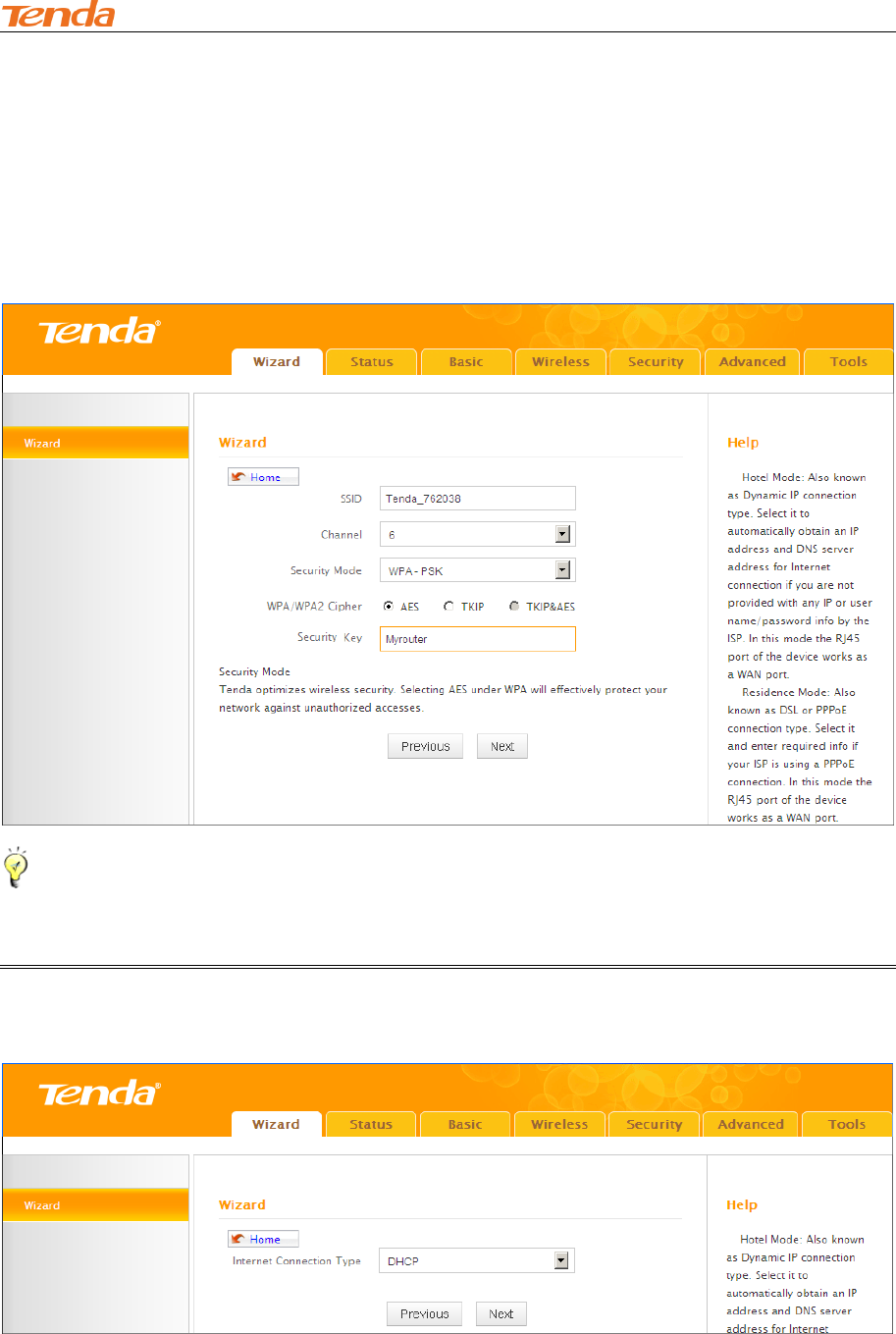
II Quick Internet Setup
23
③ Configure your wireless network: SSID and security settings and then click Next.
SSID:Tenda_762038
Security Mode: WPA-PSK
Cipher Type: AES
Security Key: Myrouter
Tip-------------------------------------------------------------------------------------------------------------------------------------------
In WISP mode, your wireless network must be set to operate on the same channel as your WISP
AP.
④ Internet Setup: Configure the Internet connection settings and then click Next. If you are
unsure, consult your WISP.
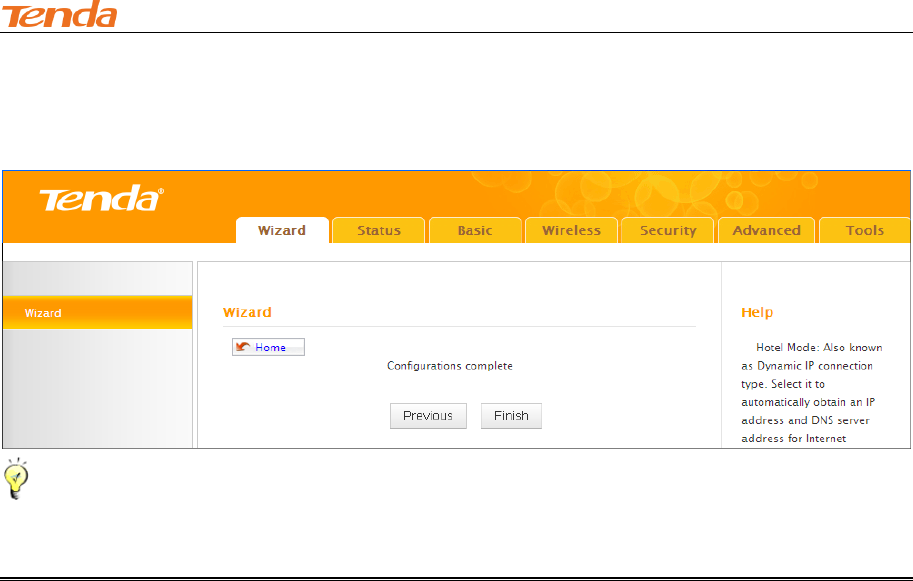
II Quick Internet Setup
24
⑤ Click Finish and wait for the device to restart automatically. After reboot, reconnect to this
device wirelessly or using an Ethernet cable and you will be able to access Internet.
Tip-------------------------------------------------------------------------------------------------------------------------
Upon successful configuration, the RJ-45 port on the device functions as a LAN port and clients
can access the device either wirelessly or via a wired connection.
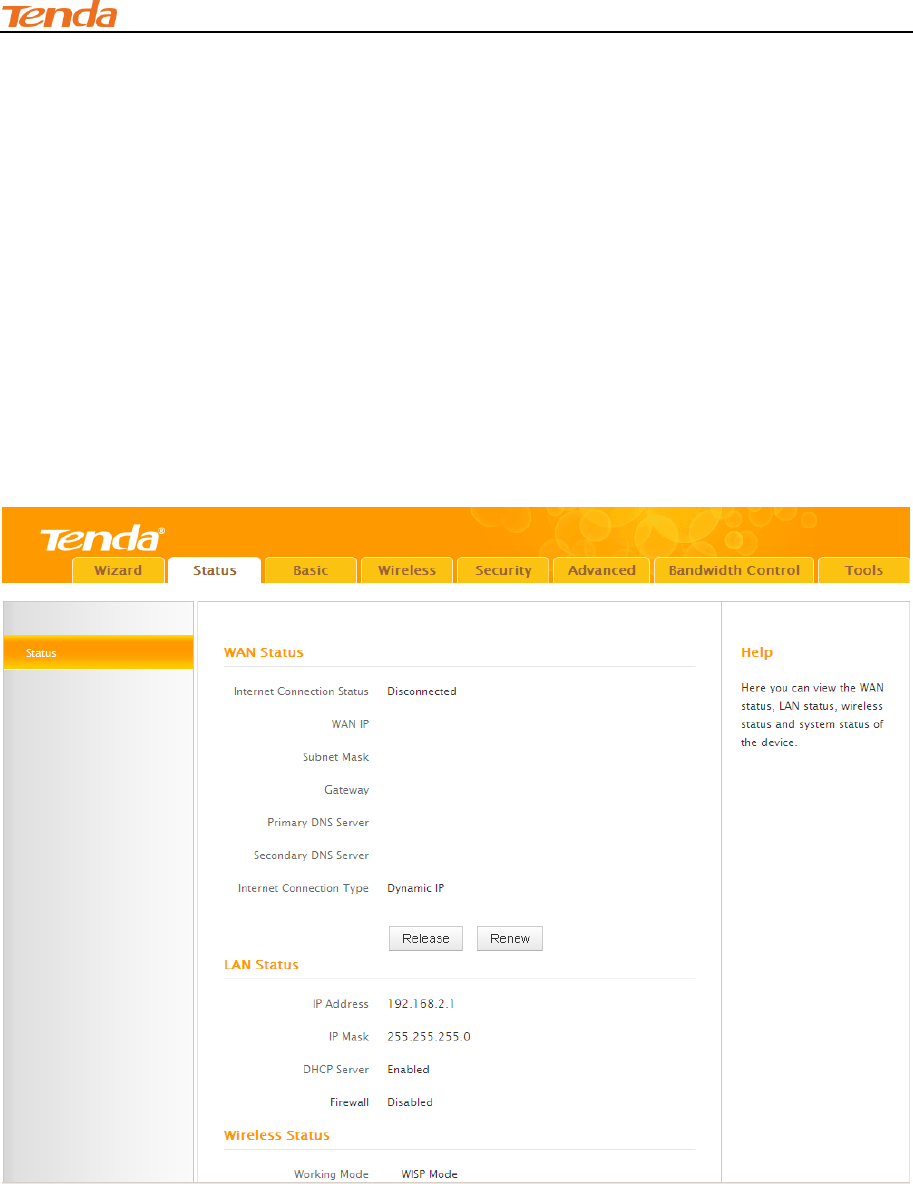
III Features & Configurations
25
III Features & Configurations
1 Status
This section includes the following:
WAN Status
LAN Status
Wireless Status
System Status
Click Status to enter the page.

III Features & Configurations
26
1.1 WAN Status
WAN Status in Wireless Router Mode & WISP Mode (WISP Client Router Mode):
WAN Status in 3G/4G Router Mode:
Tip--------------------------------------------------------------------------------------------------------------------------------------------
IP Address/Subnet Mask/WAN subnet mask/Gateway/Primary DNS Server/Secondary DNS
Server: This type of information appears only if the router successfully connects to Internet via a
PPPoE or DHCP (dynamic IP) connection. However if you connect the router to Internet with static
IP settings provided by your ISP, these fields will display the settings you entered whether the
router successfully connects to the Internet or not.
If nothing appears in the secondary DNS server field, there is no available secondary DNS server.
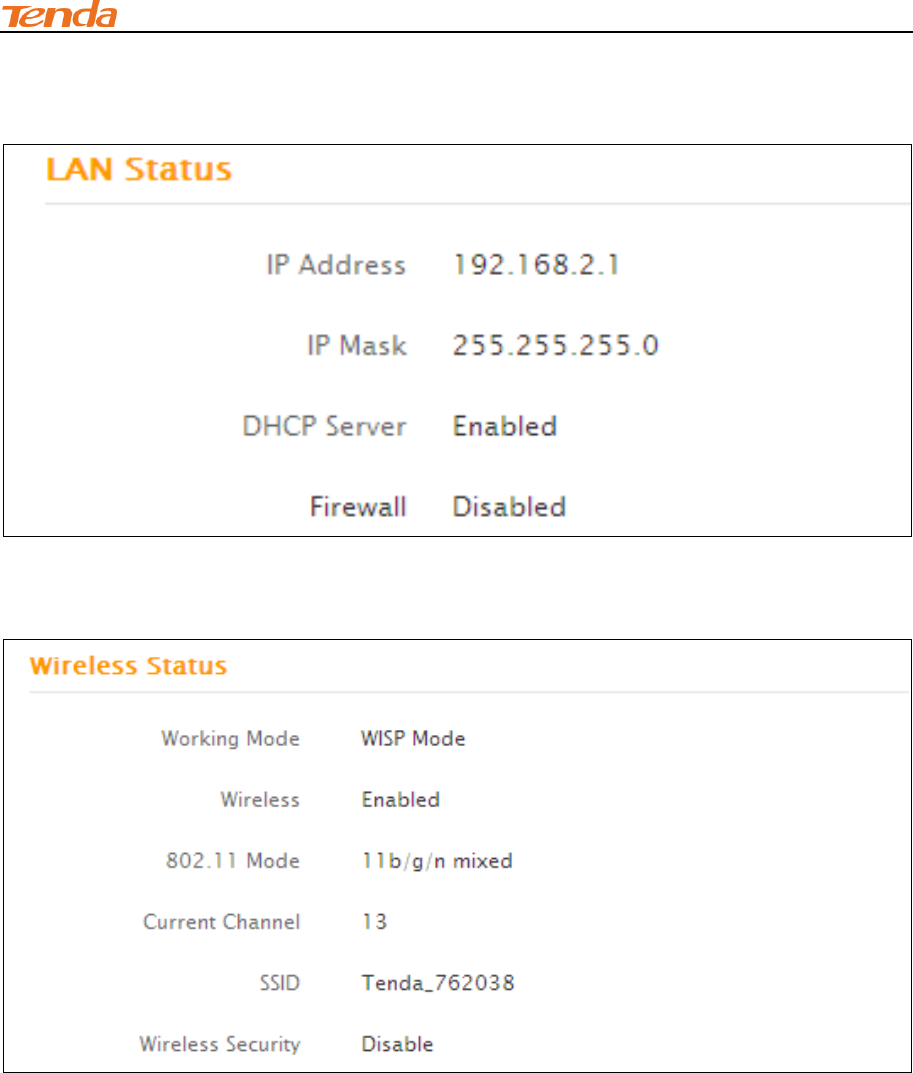
III Features & Configurations
27
1.2 LAN Status
1.3 Wireless Status
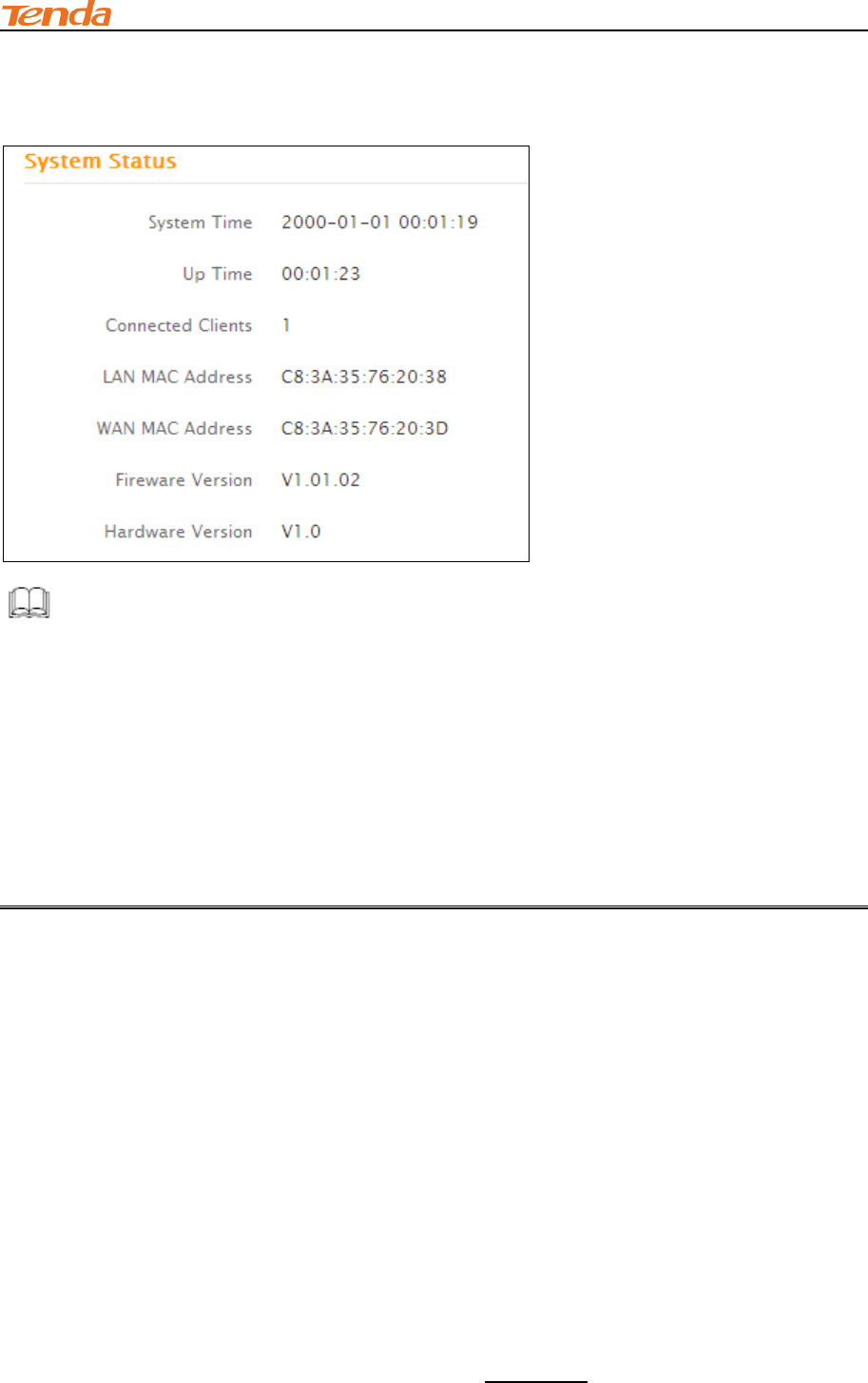
III Features & Configurations
28
1.4 System Status
Knowledge Center ----------------------------------------------------------------------------------------------
1. WAN MAC Address: The device’s current WAN MAC address.
2. System Time: Current system time on this device. The device automatically synchronizes the
system time with Internet time servers.
3. Up Time: Displays the time duration indicating how long the router has been up since startup.
Up time is recounted and renewed upon poweroff.
4. Connected Clients: Displays the number of DHCP clients.
2 Basic Settings
This section includes the following:
LAN Setup
WAN Setup
WAN Speed
DNS Settings
MAC Clone
DHCP Server
DHCP Client List
To change the device's login IP address, see LAN Setup.
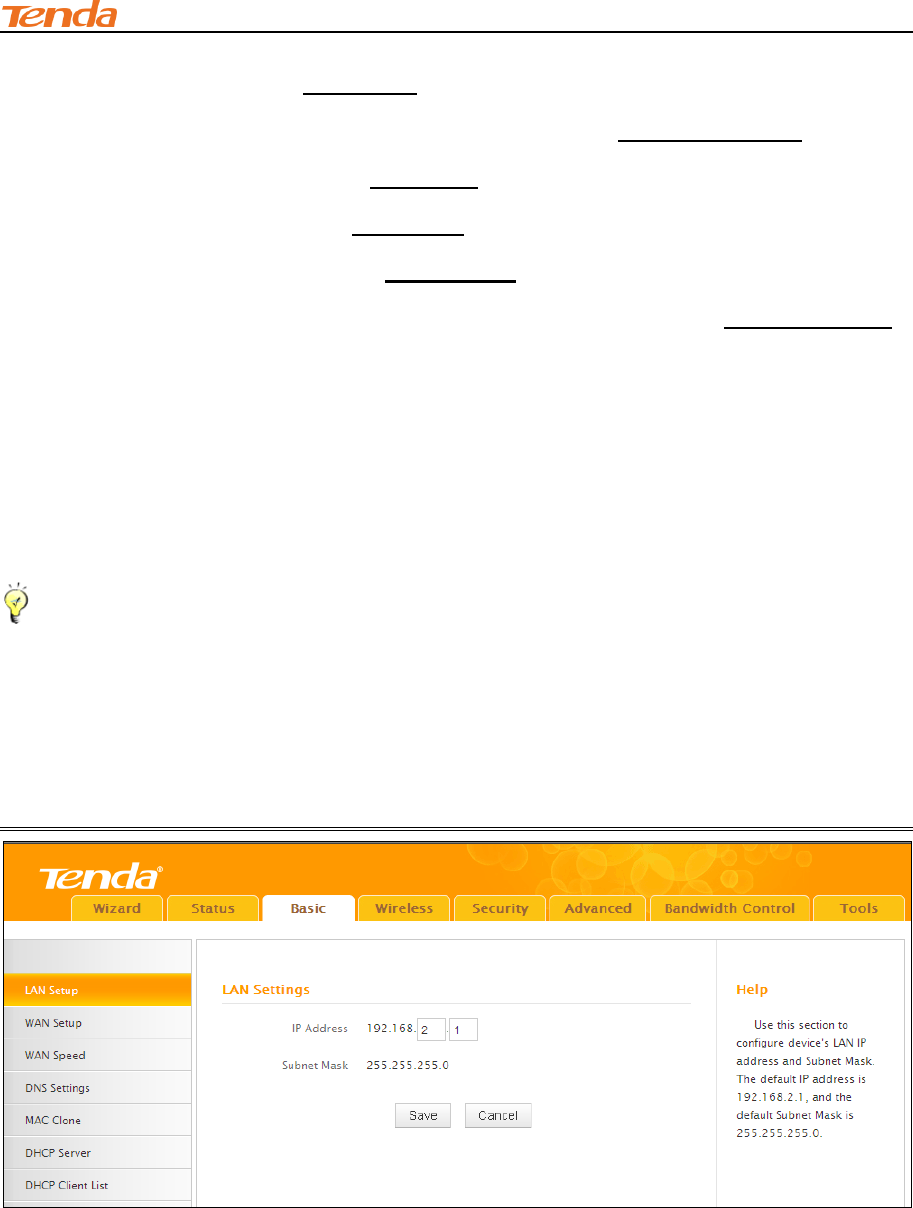
III Features & Configurations
29
To set up Internet, see WAN Setup.
To set up speed and duplex mode for the WAN port, see WAN Speed Setup.
To configure DNS server, see DNS Setup.
To clone MAC address, see MAC Clone.
To configure DHCP server, see DHCP Server.
To assign static IP addresses and view LAN device information, see DHCP Client List.
2.1 LAN Settings
Here you can configure the LAN IP Address and Subnet Mask. This IP address is to be used to
access the device’s settings through a web browser. Be sure to make a note of any changes you
apply to this page.
Tip-------------------------------------------------------------------------------------------------------------------------------------------
1.Default IP address and subnet mask are respectively 192.168.2.1 and 255.255.255.0.
2. Be sure to make a note of any changes you apply to this page. If you change the LAN IP
address of the router, you have to open a new connection to the new IP address and log in again.
Also, you have to set the default gateway addresses of all LAN PCs to this new IP address.
3. The router's LAN IP address and WAN IP address cannot be on the same IP segment. If not,
the router will not be able to access Internet.
Configuration Procedures:
① Change the IP address to the one you wish to use, for example, 192.168.10.1.
② Click Save to save your settings.

III Features & Configurations
30
2.2 WAN Settings
Click Basic -> WAN Setup to configure your Internet connection settings.
3G/4G Router Mode
Configuration Procedures:
① Country: Select your country.
② Service Provider: Select your 3G/4G ISP.
③ User Name/Password: Enter the user name and password for 3G/4G Internet service.
④ Click Save.
Knowledge Center ----------------------------------------------------------------------------------------------
Connect Automatically: Connect automatically to the Internet after rebooting the system or
connection failure.

III Features & Configurations
31
Connect Manually: Require the user to manually connect to the Internet before each session.
Connect On Demand: Re-establish connection to the Internet only when there is data
transmitting.
Connect During Specified Time Period: Connect automatically to the Internet during a specified
time length.
Wireless Router & WISP Client Router Mode
A. Select PPPoE if your ISP uses a PPPoE connection and gives you a PPPoE user name and a
PPPoE password.
B. Select Static IP if your ISP provides you with fixed or static IP address settings (special
deployment by ISP; this is rare).
C.Select DHCP (Dynamic IP) if you can access Internet simply by directly connecting your
computer to an Internet-enabled ADSL/Cable modem without configuring any settings.

III Features & Configurations
32
PPPoE
Configuration Procedures:
① Internet Connection Type: Select PPPoE.
② ISP Username: Enter the ISP login name.
③ ISP Password: Enter the ISP login password.
④ Click Save to save your settings.
Knowledge Center ----------------------------------------------------------------------------------------------
1. MTU: The MTU (maximum transmission unit) is the largest data packet a network device
transmits. The normal MTU value for most Ethernet networks is 1500 bytes, or 1492 bytes for
PPPoE connections. For some ISPs, you might need to change the MTU. This is rarely required,
and should not be done unless you are sure it is necessary for your ISP connection. For more
information, see WAN MTU Setup.
2. Service Name: This is the descriptive name of the current connection. Only enter it if your
ISP provides it.

III Features & Configurations
33
3. Server Name: This is the descriptive name of the server. Only enter it if your ISP provides it.
Static IP
Configuration Procedures:
① Internet Connection Type: Select Static IP.
② IP Address/Subnet Mask/WAN subnet mask/Gateway/Primary DNS Server/Secondary
DNS Server: Enter the ISP information you gathered in 1GettingPrepared.
③ Click Save to save your settings.

III Features & Configurations
34
DHCP
Configuration Procedures:
① Internet Connection Type: Select DHCP.
② Click Save to save your settings.
WAN MTU Setup
The MTU (maximum transmission unit) is the largest data packet a network device transmits. The
normal MTU value for most Ethernet networks is 1500 bytes, or 1492 bytes for PPPoE
connections. For some ISPs, you might need to change the MTU. This is rarely required, and
should not be done unless you are sure it is necessary for your ISP connection. When one
network device communicates across the Internet with another, the data packets travel through
many devices along the way. If a device in the data path has a smaller MTU value than the other
devices, the data packets have to be "fragmented" to accommodate the device with the smallest
MTU value.
The best MTU value is often just the factory default value. In some situations, changing the MTU
value fixes one problem but causes another. Leave the MTU unchanged unless one of these
situations occurs:
A. You have problems connecting to your ISP or other Internet service, and either your ISP or our
technical support suggests changing the MTU value. Below web-based applications might require
an MTU change:

III Features & Configurations
35
A secure website that does not open, or displays only part of a web page
Yahoo email
MSN portal
B. You use VPN and encounter serious performance problems.
C. You used a program to optimize MTU for performance reasons, and now you have connectivity
or performance problems.
If you suspect an MTU
problem, try changing the MTU to 1400. If this does not help, gradually reduce the MTU from the
maximum value of 1500 until the problem disappears.

III Features & Configurations
36
The common MTU sizes and applications are listed in the table below.
MTU
Application
1500
Typical for connections that do not use PPPoE or VPN.
1492
Used in PPPoE environments.
1472
Maximum size to use for pinging. (Larger packets are
fragmented.)
1468
Used in some DHCP environments.
1436
Used in PPTP environments or with VPN.
Note ---------------------------------------------------------------------------------------------------------------------
A wrong/improper MTU value may cause Internet communication problems. For example, you
may be unable to access certain websites, frames within websites, secure login pages, or FTP or
POP servers.
2.3 WAN Speed
Click Basic -> WAN Speed to the configuration interface. Here you can configure the WAN speed
and duplex mode.
Tip--------------------------------------------------------------------------------------------------------------------------------------------
1. The router operates in "Auto-negotiation" (or Auto) mode by default. Usually, it works for most
cases.
In some situations, you might need to change the port mode. For example, if the cable connected
to your router's WAN port is longer than 100m, you may need to use 10M full-duplex or 10M
half-duplex for better performance. Ensure that your router's WAN port operates with the same
speed and duplex mode as the remote link partner. If not, your router's WAN port may not receive
and send data.

III Features & Configurations
37
2.4 DNS Settings
Click Basic -> DNS Settings to enter the DNS configuration interface.
Configuration Procedures:
① DNS Settings: Check to enable the DNS settings.
② Primary DNS Server: Enter the IP address of your ISP’s primary DNS server.
③ Secondary DNS Address: If a secondary DNS server address is available, enter it here. This
field is optional.
④ Click Save to save your settings.
Note ---------------------------------------------------------------------------------------------------------------------
The default DNS settings are recommended. Only change the DNS default settings if you know
that your ISP requires specific servers. If incorrect DNS settings are configured, webpages will be
unable to open.

III Features & Configurations
38
2.5 MAC Clone
Some ISPs (Internet Service Providers) require end-user's MAC address to access their network.
This feature copies your current PC's MAC address to the router. Click Basic -> MAC Clone to
enter the MAC Clone screen.
Knowledge Cente------------------------------------------------------------------------------------------------
1. Restore Default MAC: Reset the router’s WAN MAC to factory default.
2. Clone MAC: Clicking this button copies the MAC address of the computer that you are now
using to the router. Also, you can manually enter the MAC address that you want to use. You have
to use the computer whose MAC address is allowed by your ISP.
To restore default MAC address:
① Click Restore Default MAC.
② Click Save to save your settings.
To clone the MAC address of the computer that you are now using to the router:
① Click Clone MAC.
② Click Save to save your settings.
To manually enter the MAC address allowed by your ISP:
① Enter the MAC address allowed by your ISP.

III Features & Configurations
39
② Click Save to save your settings.
2.6. DHCP
DHCP (Dynamic Host Configuration Protocol) assigns an IP address to each device on the
LAN/private network. When you enable the DHCP Server, the DHCP Server will automatically
allocate an unused IP address from the IP address pool specified in this screen to the requesting
device as long as the device is set to "Obtain an IP Address Automatically". If you disable this
feature, you have to manually configure the TCP/IP settings for all PCs on your LAN to access
Internet.
Click Basic -> DHCP Server to enter the DHCP Server screen. Here you can change the DHCP
IP address pool and lease time.
Configuration Procedures:
① DHCP Server: Select whether to enable or disable the DHCP server feature.
② Start IP/End IP: You can specify the starting and ending address of the IP address pool
here. These addresses should be part of the same IP address subnet as the router’s LAN IP
address.

III Features & Configurations
40
③ Lease Time: The lease time is a time length that the IP address is assigned to each device
before it is refreshed.
④ Click Save to save your settings.
Tip--------------------------------------------------------------------------------------------------------------------------------------------
By default, the router functions as a DHCP server. Do not disable the DHCP server feature unless
you want to manually configure the TCP/IP settings for all PCs on your LAN.
1. Lease time will be renewed automatically upon expiry. No additional configurations are
needed.
2. If you are not an advanced user, the default DHCP server settings are recommended.
2.7 DHCP Client List
Click Basic -> DHCP Client List. Here you can view the DHCP dynamic client list, which includes
host name, IP address, MAC address, and lease time information.
Tip---------------------------------------------------------------------------------------------------------------------------------------------
You can know whether there are unauthorized accesses by viewing the client list.
Also, you can specify a reserved IP address for a PC in the LAN. That PC will always receive the
same IP address each time when it accesses the DHCP server. Reserved IP addresses could be
assigned to servers that require permanent IP settings.
Static Assignment Application Example:
To have a PC at the MAC address of 44:37:E6:4F:37:3B always receive the same IP address of